
Sexualization of Atheltic Uniforms Drag Kings of Vancouver Sex Sells
SEX February 2024 Volume 56 Issue No. 06
 Freya Emery (she/her)
Freya Emery (she/her)
“Poppy
Seed Lover”
 FREYA EMERY (SHE/HER)
Editor-In-Chief
FREYA EMERY (SHE/HER)
Editor-In-Chief
“I love to knit on the side! I just finished my fourth hat with a matching pair of gloves”
LETTER FROM THE EDITOR’S DESK
YOU ARE YOUR OWN VALENTINE
As we gradually enter the season of love, it’s natural to consider focusing on and sharing affection with those around us. However, I believe it’s the perfect time to shift that focus inward and pay attention to oneself. Now, give me a minute. I’m not suggesting completely shutting out those around you; just remember that self-love is as crucial as showering affection on friends and lovers. February is the perfect month to look more internally and pamper yourself a little more than usual. Think about it; we’re emerging from the darkest days of the year, and it’s one of the more stressful times of the term. We all deserve to relax a bit more.
Consider this month an opportunity for a personal rendezvous. Treat yourself to a solo date night dedicated entirely to your wellbeing and recharge from the hectic winter season. Here are a few ideas for self-dates:
d d d
Solo Dinner for One
Have you wanted to cook a certain dish you know you’d love but haven’t found the time to? This is a chance to indulge in your culinary preferences without compromise. Choose your favorite restaurant, or cook a special meal at home. Set the table, light some candles, and savor each bite.
Spa Day at Home
Perhaps your hair needs a deep condition, or the heels of your feet have felt a little neglected. Take the night off just for yourself and transform your space into a sanctuary of relaxation. Run a warm bath, light scented candles, and pamper yourself with luxurious skincare.
Crafting a Gift
During the Valentine’s season, it’s rare when you make yourself a gift! Take the time to crochet a new hat, write yourself a poem, or create a new piece of art (stick figures are welcome). Whatever the craft, take a moment and create something just for yourself.
This Valentine’s season, let’s focus on celebrating our love for ourselves. Even though I find myself in a happy and healthy relationship and will be spending time with my partner, I’ll also be prioritizing myself this year! I highly encourage all of you to do the same, regardless of your relationship status.
With love, -Freya
3
CREW






COORDINATING EDITOR
Matt Shipley (he/him) matt@capilanocourier.com
“I finished high school in France.”
BUSINESS MANAGER
Terrance Alanis (he/him) business@capilanocourier.com
“I downloaded Duolingo to learn Spanish a few months ago. Mi Espanol es mejor de mi Tagalog!”
NEWS EDITOR
Bridget Stringer Holden (she/her) bridget@capilanocourier.com
“I’ve been around the world in less than 80 days”
SPORTS EDITOR
Mya Fraser (she/her) sports@capilanocourier.com
“Currently watching Game of Thrones”
FEATURES EDITOR
Gates Annai (they/she) gates@capilanocourier.com
“Ask me about the alternate universe in which I am buddy-cop detectives with John Mulaney”
ARTS AND CULTURES EDITOR
Gwen Pemberton (she/her) gwen@capilanocourier.com
“I read 32 books last year, this year my goal is 33.”
4
CREW






COMMUNITIES EDITOR
Avery Nowicki (they/them) avery@capilanocourier.com
“I’m re-reading Joan Didion this month! *woop* *woop*!”
OPINIONS EDITOR
Jayde Atchison (she/her) jayde@capilanocourier.com
“I’m either watching Real Housewives or gruesome murder shows, there is no middle ground”
COLUMNS EDITOR
Sara Brinkac (she/they) sara@capilanocourier.com
“My older sisters name is Teghan so, together, we are Teghan and Sara (we are not named after the duo my parents promise)”
ART DIRECTOR
Angelica Blanch (she/her) design@capilanocourier.com
“My favorite typeface is Editorial New.”
PRODUCTION MANAGER & CREW ILLUSTRATOR
Andy Poystila (he/him) production@capilanocourier.com
“I am also left-handed! ):)”
VIDEO PRODUCTION & COMMUNICATIONS MANAGER
Laura Morales Padilla (she/her) videoproduction@capilanocourier.com
“I’m just waiting for Terrence to reach conversational-level Spanish to teach him some slang.”
5
CREW





VIDEO EDITOR
Ely Davidson (he/him) videoeditor@capilanocourier.com
VIDEOGRAPHER
Dylan Smith (he/him) videography@capilanocourier.com
CREW WRITER
Lea Krusemeyer (she/her)
“I used to be a super fan of Ellen Degeneres. I still have two tattoos dedicated to her, I never really regretted getting them but I for sure wouldn’t do it again.”
CREW WRITER
Kirsten Wiltshire (she/her)
“I quoted Buster Bluth in my highschool graduation yearbook but it didn’t get printed because it was either too inappropriate or we didn’t have the rights. Either way, I love soup as much as he does.”
CREW ILLUSTRATOR
Chelle Lussi (Any)
“My love for cats wearing cowboy hats is so strong that sometimes I tear up.”
6
CONTRIBUTORS
CONTRIBUTING WRITERS
Mizuki Kinoshita, Samantha Craig, Saul Morales, Jasmin Linton, Mikaila Poirer, Ayla Maxwell, Ashlea McCrae, Jasmine Garcha.
CONTRIBUTING ARTISTS
Tanner McMahon, Bells White, Apsara
Coeffic-Neou, Taylore Lawrence, Ethan Woronko, Noureen Elsayed, Natasha Lee, Sasha Lun, Cassandra VP, Jasmin Linton, Eva Staub, Valentina Kruglikovskaya, Alina Sandu, JJ Eng, Natasha Jones, Yohahnah L, Sol Yoon, Cameron Skorulski, Cassandra Valenzuela Poon, Celina Zhong, Lucy Benson.
FEATURED ARTISTS
Freya Emery, Mesh Devkota, Charlie Wongpisethkul, Cameron Skorulski, Angelica Blanch, Annika Yi.
COVER ART
Bells White.
WANT TO CONTRIBUTE?
Email editor@capilanocourier.com for interested writers. For aspiring illustrators, they are required to send a portfolio or sample of work to production@capilanocourier.com.
@capilano.courier capilanocourier.com
7

MESH DEVKOTA (he/him) “3D FLOWERS”
8 FEATURED ARTIST
TABLE OF CONTENTS VOLUME 56 ISSUE 06 9 NEWS COMMUNITIES ARTS & CULTURE OPINIONS FEATURES SPORTS Coordinating Consent Bus Rapid Transit Routes 10 Winter Water Sports 16 40 Three Date Theology 52 Love and Other Vices 46 Sex Sells ThirstTok With Thoren Tinder, Grindr, and Co. 18 19 20 36 34 32 The Mythical Origins of the Vibrator Drag Kings and Things of Vancouver Sex Onscreen Battle of Bookstagram Touching or Tacky 42 44 50 54 56 No More Waitlists 12 14 Sexualization of Athletic Uniforms Motivation or Distraction? Meet the Engaged CapU Receives Its Largest Research Grant to Date Learning Through Competing A Final Goodbye to Reader’s Digest Canada What Is In For This Year’s Valentine’s Day Vancouver’s Black History Month 24 26 28 30 Neutral Nudes 58 COLUMNS Student, Abroad Literally Speaking Now How ‘Bout That Airplane Mode 60 62 66 64
New Bus Rapid Transit Routes Continue to Pass
By Capilano University
CSU VP External Manpreet urges students to fill out Translink’s feedback forms and join consultations

NEWS EDITOR
(SHE/HER) ILLUSTRATOR
10 SEX
TANNER MCMAHON
BRIDGET STRINGER-HOLDEN
(HE/HIM)
Translink announced their new Bus Rapid Transit routes late last year. This includes an extension to the R2 RapidBus from Phibbs Exchange to Metrotown. However, the Capilano Students’ Union (CSU) argues that it does little to solve the issues that Capilano University students have been enduring for years.
“It’s not necessarily a bad thing,” said CSU VP External Manpreet. “It’s exciting for the North Shore to have a bus rapid transit route, we would just like to be included as a stop because it would help get students across the bridge, but we want them to come to campus, not just Phibbs Exchange.”
Manpreet has served as VP External since June, and been a part of the CSU for a year and a half. She is also the Chairperson for the Alliance of BC Students (ABCS), a non-partisan coalition of five student associations across B.C., which represents approximately 80,000 postsecondary students.
In these roles, Manpreet deals with a variety of external organizations, such as other student unions, provincial organizations such as the British Columbia Federation of Students, and local, provincial and federal governments.
“Anytime we meet with an office holder—whether local, provincial or federal—we talk to them about this,” she said. While the local governments have the most say over transit, the CSU has asked the provincial and federal government for more bus rapid transit funding. “The provincial government allocates money to projects, so we tell them this is important to us,” Manpreet adds. “And then, with the local government, we say we want to participate in consultations and make sure we’re saying our part.”
In 2020, CapU lost three buses that came directly to campus, which were replaced by the 245 which shuttled students from Phibbs Exchange. According to a survey conducted by the CSU for the 2022-2023 academic year, half the respondents spent over two hours commuting each day. A quarter rode transit for more than three hours daily, and students faced up to a three bus wait at Phibbs Exchange in the morning.
“The BRT is an exciting project, but CapU isn’t on it, and that’s an issue for us because we see so many long lines at Phibbs,” Manpreet said, “and now because of the construction there’s not enough space to hold students on the platforms—it’s not really safe.”
There are plans to extend the R2 RapidBus to Metrotown, which will include stops at Brentwood Skytrain Station and BCIT but not CapU. When asked, TransLink explained that going to CapU would be a significant detour, but there will be public consultations in the coming months.
Manpreet urges students to join any consultation opportunities, and fill out the feedback form on TransLink’s website to let them know which times are the most busy and in need of increased bus service.
“If enough people say they want CapU to be included, it might work out—it’s not fixed yet,” she said, adding that TransLink decides bus wait times but that it’s not an easy process and they really need something to justify big decisions like adding another bus or increasing frequencies. “They often look at the numbers from past years and decide how to go about it—having direct feedback from students would be a present snapshot for them.”
In the short-term, the CSU is advocating for increased 245 frequency, and an extended bus during peak hours. In the long-term, they hope for buses to come all the way to campus.
“We’ve been working on this for years, and we will continue to do so,” she said, emphasizing that students should fill out the Translink feedback forms and join any consultations they see. “Because again, when I say I represent so many students and say that we need this, it’s helpful, but if students actually join, they get to see personal stories.”

11 NEWS
CapU Receives Its Largest Research Grant to Date
The $1.5 million NSERC grant will fund various climate initiatives
NEWS EDITOR
BRIDGET STRINGER-HOLDEN (SHE/HER)
ILLUSTRATOR
APSARA COEFFIC-NEOU (SHE/HER)

12 NEWS
CapU recently received its first ever grant from the Natural Sciences and Engineering Research Council of Canada (NSERC). The Tri-Council is Canada’s major federal post-secondary research funding agency and includes NSERC, the Social Sciences and Humanities Research Council (SSHRC) and the Canadian Institutes of Health Research (CIHR).
Apart from being the university’s first application to NSERC, the Mobilize grant for applied research on regional climate action also happens to be CapU’s largest research grant to date. It is valued at $1.5 million and will be distributed over five years.
“We heard the good news in late summer but had to keep it under wraps until the federal government announced the awards in December,” said Dr. Dawn Whitworth, CapU’s Associate Vice President of Creative Activity, Research and Scholarship & Graduate Studies. “We were dying to tell the whole CapU community as we knew it would create lots of partnership opportunities backed with paid research assistantships for CapU students and section releases/teaching buyouts for CapU faculty.”
Whitworth started working at CapU a few months before the pandemic, and has been focusing on building capacity in creative activity, research and scholarship. Before coming to CapU, she worked in leadership roles at both UBC and Emily Carr — both of which had a focus in research and innovation.
The Mobilize grant is intended on building research capacity with faculty and students across CapU’s campuses, learning sites and faculties.
“The grant application asked us to identify a core research theme, and we knew early on that it was an opportunity to support one of CapUs strongest research areas — sustainability,” said Whitworth.
Some of CapU’s existing partnerships include the Howe Sound Biosphere Region Initiative Society (HSBRIS) and the North Vancouver Chamber of Commerce. Both the HSBRIS and the Chamber supported the grant application with detailed letters of support.
Ten faculty members also supported the application: Amir Amiraslani, Tong Chow, Tom Flower, Cheryl Schreader, Hojat Yazdanpanah, Mohna Baichoo, Paolo Fresnoza, Roy Jantzen, Nancy van Groll and Sabrina Wong. Whitworth considered their expert CVs and experience in sustainability research and work integrated learning as an important part of the application.
Various projects will be supported by the grant, including Tom Flower’s work with HSBRIS and Nancy van Groll and Cheryl Schreader’s work with Earthworks, a multidisciplinary initiative that includes lectures and environmental restoration initiatives. There are also plans for an upcoming UN Sustainable Development Goals week in partnership with the City of North Vancouver, Enactus and City Studio.
Additionally, there is the possibility of a new Centre for Interdisciplinary Research on Sustainability to bring together researchers, students, partner organizations and companies in joint research projects. However, this will be done in a phased approach, which will require consultation, policy and procedural steps.
An NSERC Steering Committee was formed late last year. It includes the ten faculty members who helped with the application and will adjudicate applications for NSERC funding to support research projects, partnerships and student research assistants going forward.
“What I’ve learned about CapU is that there are always exciting faculty-led partnerships in the works and this new grant ensures that going forward they’ll be fully-funded,” Whitworth said, excited to share that the grant is also renewable.
13 NEWS
No More Waitlists
CapU transitions to a waitlist-free add/drop period
CONTRIBUTOR
MIZUKI KINOSHITA (SHE/HER)
COORDINATING EDITOR
MATT SHIPLEY (HE/HIM)
ILLUSTRATOR
TAYLORE LAWRENCE (SHE/HER)
From the beginning of the Spring 2024 semester, Capilano University will adopt a new course registration system. This system was built with the intent of removing long waitlists, though it falls short of addressing the issue of insufficient space in required courses.
Historically, the waitlist system operated on a firstcome-first-serve model, where the first student in line would be given 24 hours’ notice to accept a seat in their desired class when a spot became available. This system will still be active until the first day of classes, at which point the waitlist will be cleared and all waitlisted students will have equal opportunity to enroll in a class when seats become available.
“Once the semester started, some waitlisted students who wanted to drop a course were being charged erroneous fees,” said Kyle Vuorinen, Registrar at CapU. “You shouldn’t be charged fees for things like dropping off of a waitlist. When we did an investigation into why this was happening, it turned out to be a defect with the student information system that we use—one provided by an external vendor.”
Other institutions have moved to this new registration system due to the same software defects, including Kwantlen Polytechnic University and Douglas College. This change means that students will no longer have to pay inappropriate drop fees for leaving waitlists, but luck will now be a main factor in course registration during
14 NEWS
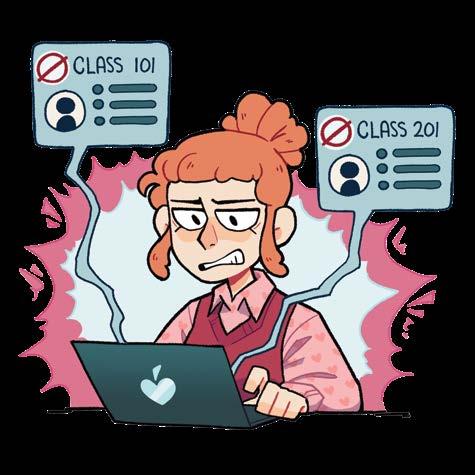
the add/drop period. When a seat becomes available in a course, the first student to notice and take action will take that seat.
Especially in required courses such as ENGL 100, it can be difficult to fit all students who need the course into the limited class spaces. Vuorinen stresses that “if an instructor agrees with a student, a student can take the course whether or not they make it in through the registration system.” Importantly, this is not a golden ticket—class sizes are limited and while professors have some room to help, nothing is guaranteed.
CapU plans to continue using this system in the future, whether or not the student information software vendor fixes their bugs. As with any new system, it will be improved over time, in part owing to the future opinions and efforts of students and the CSU.
15 NEWS
Winter Water Sports
A look into the tight-knit community taking summer sports to the snow
COORDINATING EDITOR
MATT SHIPLEY (HE/HIM)
ILLUSTRATOR
ETHAN WORONKO (HE/HIM)
“Anyone down to kayak the Capilano today?”
It’s a benign enough question. When the North Shore rivers are in—meaning that they have enough water flowing through them to be runnable in a kayak—members of the Vancouver Whitewater Club (VWC) are not a rare sight on the water. The catch, though, is that the rivers are only runnable after a considerable amount of rain, meaning that the North Vancouver kayaking season typically runs best from November to May. This particular message was sent on a frosty January morning.
“For those of us accustomed to wearing dry suits, it’s actually better to paddle in the winter than the summer,” says Dave Sitar, a longstanding member of the Vancouver whitewater community.
“For safety on cold water rivers, kayakers normally wear a full dry suit with an insulation layer every month of the year—so it’s
better to paddle comfortably in 5-15°C weather in the fall/ winter/spring than roast in your own sweat in the summer when it’s over 25°C.”
Most rivers in North Vancouver and the Sea to Sky corridor are fed directly by snowmelt and glacier meltwater, meaning that they remain uncommonly cold year-round. While river users may not be planning to flip or swim, a drysuit could mean the difference between a fun day and a hypothermic one—even in August. However, wearing a drysuit in August is a sweaty, uncomfortable experience, while the same suit in December provides just enough protection from the cold air to be comfortable at all times.
Many cold-water enthusiasts simply enjoy the act of experiencing something few people ever do. “I did the Cap
16 SEX
t t t t t t t t t
yesterday, and as I got into one of the big eddies about five rapids down where the big waterfall is on the river’s left. I noticed the beautiful icicles all over the canyon walls,” says Glen Backus, another regular North Shore river user.
“I knew not to paddle under them as the temperatures yesterday were rising. Just as I was admiring the wall, a giant 20 foot by 10 foot ice chunk came off the side of the waterfall and crashed into the water in front of me, covering me with a wave. It was a magical experience that I wish I’d had a camera to catch.”
Advancements in cold-water gear technology have given a whole new meaning to the term “year-round sport.” Much of North Vancouver’s unique multi-sport culture stems from the need to switch sports as the seasons change, but that mindset is quickly shifting—especially in the water sports community. While historically, it took a die-hard kayak enthusiast to enjoy a frigid winter river run, today it is not uncommon to see upwards of ten paddlers dropping into the Capilano River canyon as snow blankets the city above.
“Once upon a time, we paddled the Cap in winter without drysuits or even dry tops,” reminisces Ray Robb, the VWC Trips Coordinator. “All we had were wetsuits, nylon jackets with neck and wrist seals using velcro (it was a cool new invention) and wore neoprene farmerjohns with wool gloves and toques—we hurried to get down the river before our feet froze too much to be able to walk from the river to our cars.”
The VWC oversees a thriving, welcoming community of paddlers both new and experienced. The club offers lessons for all levels, free practice sessions and a long list of river trips every season—generally from March to October. Through the winter months, they can be found on Facebook and seen in action on any river within fifty kilometers of Lonsdale Quay.
To learn more and get involved, visit https://www. vanwhitewater.com/

17 SPORTS
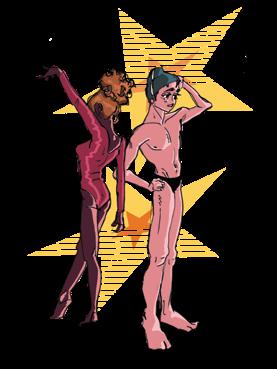
Sexualization of Athletic Uniforms
More than fabric: navigating the complexities of athletic attire
CONTRIBUTOR
SAUL MORALES (HE/HIM)
Should the uniforms in sports change over time? What impacts does the sexualization of athletic uniforms have? If the rules of the sport are not changing, why is the uniform changing? One reason for changing the uniforms could be the improvement in technology that allows for the creation of uniforms that improve the athlete’s performance in a way that wasn’t possible before.
It makes sense to think that the changes in uniforms are driven by improvements in technology that allow for the creation of better sportswear. The creation of lighter and more resistant fabric is one of the reasons, but it’s not the main reason for changes in uniforms in the last 100 years.
Professional sports serve many purposes; promoting national pride, inspiring healthy lifestyles, creating economic impacts and media or advertising opportunities. One of the main purposes, though, is entertainment. It is important to remember that the business model that allows for professional sports teams to pay their athletes relies on the sale of merchandise and tickets to the games.
Sports that gather more public attention produce more revenue. Professional soccer players make more money than professional rugby players because more money is generated in soccer matches than in rugby matches, not because they are objectively better athletes or because they play a more difficult sport.
In an attempt to increase the revenue generated, the sports industry has resorted to various tactics to engage fans and build the presence of their brand. One of the most controversial tactics has been changing the design of the uniforms to prioritize aesthetics and sex appeal over functionality and performance. A few clear examples include cheerleading and volleyball uniforms.
ILLUSTRATOR NOUREEN ELSAYED (SHE/HER)
Cheerleading uniforms face criticism because they are designed in a way that emphasizes a look considered by some as overly revealing. According to Epic Sports, skirts have been getting shorter over time, tops have been getting smaller and the overall fit is tighter.
Another uniform that faces a lot of criticism is the bikini-style attire seen in women’s beach volleyball. While the design is intended to accommodate the sport’s sandy environment, some argue that the emphasis on the revealing uniform may contribute to the sexualization of female athletes.
We can also see examples of more revealing uniforms on male athletes like the male swimmers who have been allowed to compete in the Olympics bare-chested since 1936 instead of having to wear full body suits.
The sexualization of athletic uniforms may not be universally viewed negatively by athletes themselves. Some athletes may feel empowered and confident wearing uniforms that they believe expresses their identity without negatively affecting their performance.The design of the uniform may be influenced by marketability and the desire to attract sponsorships through the use of eye-catching uniforms.
Consequently, the sexualization of athletic uniforms can contribute to the objectification of athletes. This may detract from their achievements, skills and athleticism. Tight or revealing uniforms may restrict movement or cause discomfort, affecting the athlete’s ability to compete at their best. The emphasis on sexualized uniforms can have a negative impact on body image and self-esteem, and can reinforce harmful beauty standards and expectations.
While some argue that a certain level of aesthetics is important for marketability and athlete confidence, it is important to balance this with considerations for functionality and the potential impact on the athlete’s psychology, well-being and performance. Finding the right balance will contribute to a positive and empowering sports environment for all athletes.
18 SPORTS



Motivation or Distraction
Love on the field and in the classroom
CONTRIBUTOR
JASMIN LINTON (SHE/HER)
If there is one thing to agree on, it’s that school can be stressful, oftentimes just one part of a larger, crazier schedule. Student-athletes are one community that feels this stress more acutely than most. Athletes are constantly juggling academics, family, work, sports and relationships trying to find the perfect balance. However, for the majority, streamlining schedules like that can feel impossible. Balancing the responsibilities of sports and school on top of a love life comes with many pros and cons. It is no wonder the scale seems so evenly balanced between motivation and distraction. To elaborate on this balancing act of being a student-athlete, Maya Smith from the CapU women’s soccer team talks about her experience and gives some guidance about juggling her full schedule on top of her love life.
A rather obvious upside to being in a relationship on top of academics and athletics is the endless support and motivation. Keeping up with a sport, not just physically but mentally as well, can be incredibly difficult to sustain. Smith, having met her boyfriend at CapU as he also plays soccer on the men’s soccer team, talks about how they motivate and lean on each other. “My boyfriend’s consistent support, feedback, and advice have really added to my skills and knowledge as a player,” said Smith.
Not only does this support have a positive impact on one’s mental well-being—it can also help maintain performance. Smith said “another bonus that comes from us being passionate and training towards the same goals is that we often train together in the off season.” Training together and sharing the same goals can hold athletes accountable and keep them on top of their game. As an added bonus, they might get to do them with their favourite person.
ILLUSTRATOR
NATASHA LEE (SHE/HER)
But is this kind of schedule realistic to maintain? With so many activities all jammed into one day, it’s important to prioritize tasks efficiently. Unfortunately, this can translate to one’s relationship moving to the backburner while deadlines and athletic responsibilities start stacking up. “FaceTime can be a lifesaver during peak times in the season and semester,” Smith explained on how she and her boyfriend manage to see each other amidst other priorities. Although this method of scheduling time for each other can be a good trick, she adds that “it isn’t ideal compared to being able to see each other whenever we want.”
In any relationship, there will always be struggles to find time for both partner and personal commitments. These time constraints can be a pretty big downside with athletics added on top. Smith talks about how it can be difficult to find the time to focus on her relationship while balancing those other priorities, “I don’t like saying [my boyfriend] is my lowest priority when it comes to these things, however, since our lives are so intertwined with school and athletics, I don’t always have to worry about seeing him.” Smith feels privileged to have her love-life so intertwined with her sport. She talks about how she’s thankful to have someone to share her stresses with. “Dating within athletics means having someone I’m close with who not only understands everything I’m balancing but has the same experiences.”
Navigating being a student-athlete is undeniably challenging. It only adds to the juxtaposition of academics and relationships, creating a delicate balance between motivation and distraction. Smith highlights her experience of having a supportive partner who shares similar goals and experiences. How, instead of being a distraction, the emotional and motivational support from a loving relationship can enhance both mental well-being and athletic performance.
19 SPORTS
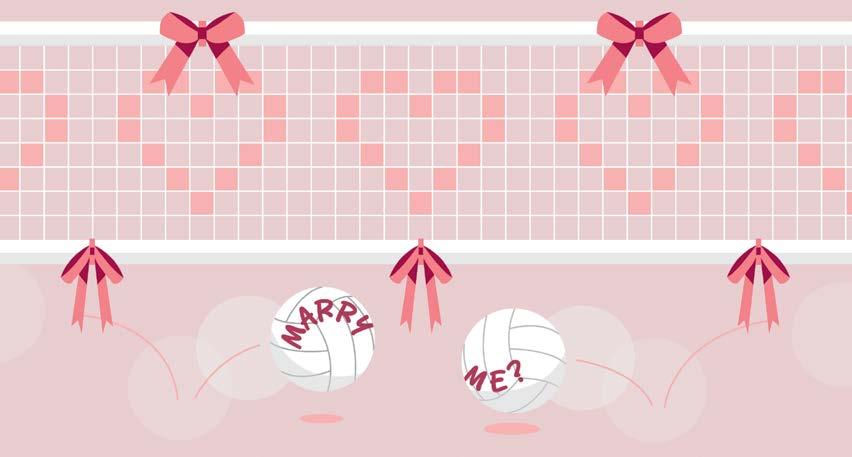
MEET THE ENGAGED
A match made at the net
SPORTS EDITOR
ILLUSTRATOR
20 SPORTS
MYA FRASER (SHE/HER)
SASHA LUN (SHE/HER)
Embarking on their CapU journeys as student athletes on the volleyball teams, Meghan Koven and Simon Friesen first crossed paths at their student athlete orientation.
Both Koven and Friesen started playing in 2015, finished playing in 2020, and graduated in 2021 with a Bachelor of Arts, Major in Interdisciplinary Studies. Koven typically played as a left side (outside hitter)/libero but graduated being able to say she played every position at least once. Friesen, former captain of the team, played the position of setter for his whole career.
Their first date was at Raglan’s, on lower Lonsdale. Upon their first few meetings, Friesen noted his initial impression of her was that “she seemed like a very cool person, and I wanted to get to know her,” while Koven stated how she instantly knew they would be good friends. “I thought he made good conversation and was super friendly.”
Throughout their time at CapU together, they found it easy to be connected. Besides playing the same sport and being in the same program, they even took some of the required courses together, allowing them to work on the same papers and projects with one another, making things more convenient. Being student athletes affected their relationship positively and was ultimately what brought them together as a couple. Friesen elaborates as more time has passed, “I’ve begun to see it more as a catalyst to bring us together because we are so similar—in lifestyles, upbringing, and values.”
Post-graduation, the pandemic halted all their previous conversations of travel. They moved in together on the North Shore and started their careers. Koven has been working at Vancity for three years, first as a teller and more recently an advisor. Friesen previously worked as a Parks Attendant for the District of West Vancouver but has just started his career as a firefighter this January. Friesen, originally from Abbotsford, comments on his move, iterating how Koven has welcomed him into her extended North Vancouver family with open arms, and the amount of joy it has given him. “My life could’ve been quite lonely, moving to the new city of North Van away from all of my friends and family, but it wasn’t. It was like being adopted.”
The pair had discussed their plans to spend their future together prior to the engagement, considering marriage, children, buying a house, their careers—all the important things. Koven had also spent time scouring the web for lots of wedding ring inspiration, which Friesen used to his advantage. A trusted friend recommended a craftsman in lower Lonsdale who could make custom rings. Sept. 23, 2023, was the day they officially became fiancées. Koven was under the impression she was heading to Caulfield Beach in West Vancouver to take photos with friends and then go out to a nice dinner. “She was dropped off, with a bit of suspicion of course due to the clear umbrellas coming out of her girlfriend’s car, but me standing with
the champagne and a photographer to capture the moment gave it all away.” They were able to celebrate that evening with many of their friends and family at the bride-to-be’s parents’ house, which Friesen planned upon getting their blessing.
When Koven was asked how she knew he was the one, she mentioned she knew right away they would be together a very long time if not their whole lives. “He’s an extremely hardworking, selfless, and genuine person. He is also kindhearted, patient, and respectful in every aspect of his life. It is truly inspirational how much time and effort he will put into something he loves and does so in the humblest fashion. He is the epitome of a team player, and this shows constantly on the court and in our daily lives at home.”
When Friesen was asked the same question, he expressed having always thought of Koven as a super special person that he wanted to be with. After moving in together and finding a great balance of reliance on one another but also individuality he was sure it was just a matter of time. “I admire her kindness and caring nature the most—she is always willing to help somebody who needs it. She is incredibly loyal to her friends and family, and regardless of small negative interactions she doesn’t let one thing change her opinion of the people she loves. She is always there to make sure I don’t lose track of myself and what’s most important.”
When they reflect on their time at CapU, they mention their love for their teammates, coaches, team trips and hangouts, provincials, national championships, the sum of the entire experience.
Friesen recounts one of his favorite memories when winning nationals was just FaceTiming Koven after the game. “Without trying to sound too cliché, but team sports kind of helped me see that sharing the moment with people or someone that is special to you is way more important than actually winning the game or tournament. She brought me back down to earth and helped me savor the moment and the feeling.”
February 15 marks their eighth year together, and they’re gearing up to say “I do” in the summer of 2025.
21 SPORTS
Charlie Wongpisethkul (they/them) “Lovers”
Life and Death are lovers. Life is always sending Death presents and Death keeps them forever.

22 FEATURED ARTIST
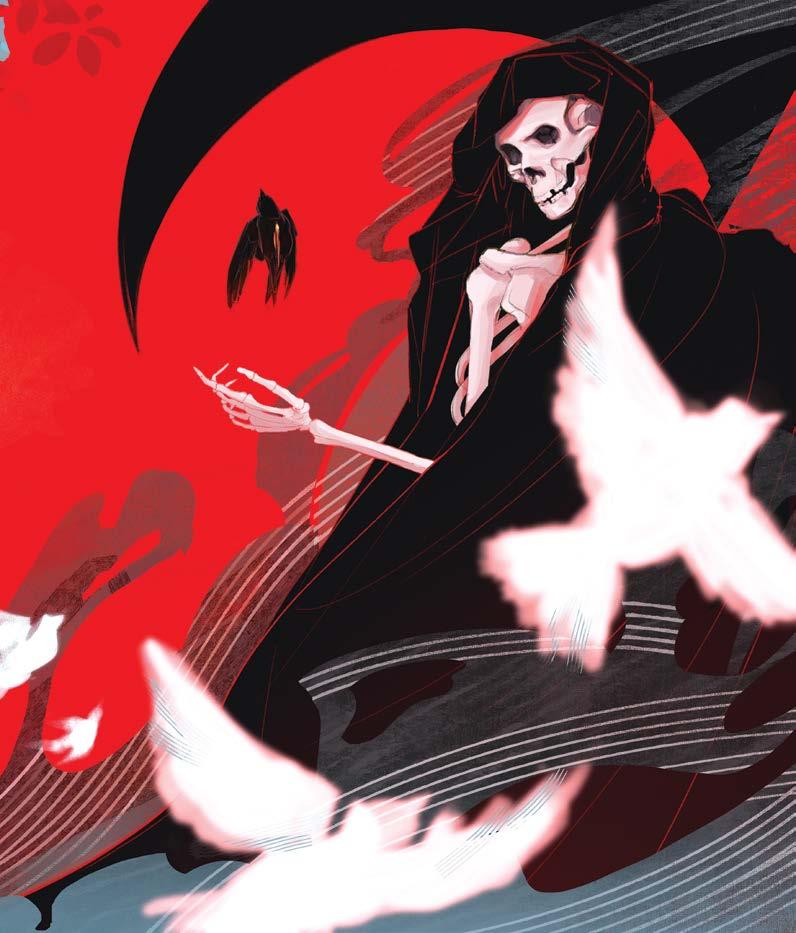
23 FEATURED ARTIST

LEARNING THROUGH COMPETING
24 SEX
My experience partaking in the CAA x LAC Case Competition
CONTRIBUTOR TERRENCE ALANIS (HE/HIM)
ILLUSTRATOR AVA SHAHRES (THEY/SHE)
On Nov. 5, 2023, business students from Capilano University and Langara College took part in the inaugural CAA x LAC Accounting Case Competition, the first ever joint business case competition hosted by the Capilano Accounting Association in collaboration with the Langara Accounting Club. Organized jointly by CAA President Yaseen Shivji and LAC Co-President Elizabeth Li, the success of the competition signifies both associations’ commitment towards the professional development of students of their institutions’ respective business programs. (CapU’s School of Business program and Langara’s School of Management Program).
This joint student competition also signifies a marquee moment in the relationship between Capilano University and Langara College, as both institutions signed a five year memorandum of understanding (MOU) in February 2023. According to their joint press release, the MOU was signed with the intention of “creating more opportunities for students to access programs across both institutions … and build greater awareness of the opportunities for students within the two institutions in an inclusive manner.”
The accounting case competition itself took place at CapU’s Lonsdale campus, located at the Shipyards in Lower Lonsdale. The numerous groups that registered for the competition were students from both CapU and Langara. Without revealing which institution they attended until the competition’s conclusion, each group had to present themselves as a fictional professional consulting firm. Each ‘firm’ had to create organizational branding assets and a corporate introductory video to fully immerse themselves into the competition experience.
On the day of the competition, the consulting firms were sent a business case scenario from both host presidents. The firms were then given three hours to provide a business solution for the scenario, and then rehearse a presentation of their solution to a diverse panel of judges.
The panel consisted of local industry professionals from numerous firms and organizations. Those in attendance included faculty members from both institutions, such as chair of the CapU School of Business Program, Tammy Towill. At the conclusion of the competition, the top three groups were awarded cash and non-cash prizes such as backpacks, stationary, and mugs,. The joint event wrapped up with a networking mixer at Tap & Barrel, where students, faculty and industry leaders mingled and connected with one another.
Although fundamental accounting knowledge was required to support the rationale of each group’s case solution, other aspects of business operations, such as marketing, branding, sales and business development were essential for creating robust and successful solutions. The necessity of knowledge beyond accounting is reflective of Chartered Professional Accountants of Canada’s efforts to expand other tangible competencies needed to be a CPA.
For example, the inclusion of data analytics and information technology competency within the program’s prerequisite requirements, which was changed from a non-core to a core pre-rec requirement for admission as of May 1, 2022. CapU’s business program started offering BFIN 348 in Fall 2022, an accounting course that covers data analytics and information
systems for accounting and finance. It’s a symbolic shift of CPABC extinguishing this preconceived notion that CPAs only need to churn out balance sheets for the rest of their lives. In many ways, accounting is the language of business and commerce. An organization’s departmental operations (marketing, sales, production, IT, etc.) are heavily influenced by the standing of their financial statements. As important as it is for non-accounting/finance executives to have a fundamental understanding of accounting, it’s important to also establish a two-way street of sharing accounting and non-accounting business and commerce knowledge among professionals.
Brad Pennefather, former VP of Business Intelligence for the Vancouver Canucks, is a CPA who started his accounting designation from a non-financial background.. According to an article by Business in Vancouver, Pennefather worked for numerous companies before he pursued his CPA Accounting designation. Despite not having any technical finance experience, his experience from other aspects of business, such as marketing and sales, enabled him to acquire his CPA. With his CPA designation, Pennyfeather was able to expand his business skill set. He was then hired as Senior Director of Marketing and subsequently promoted to VP of Business Intelligence for the Vancouver Canucks.
During the case competition, students were proactively engaged towards generating ideas and solutions for the business case problem. The finite amount of time given for case submission created a critical sense of urgency among the “firms” to create a tangible, feasible solution supported by financial statement analysis and target market metrics. Simulation can permit for a dynamic learning experience; one where concepts learned in the classroom can be applied in practice, compared to being recalled through regurgitation of $120 digital McGraw Hill textbooks and late-night repetition of hastily-made Kahoot! questions. Myself personally, I was able to implement financial and profitability ratios learned in BFIN 142 to precisely analyze the case’s balance sheets, and channel my high-school theater experience as Montague #4 to concisely orate our group presentation. Who would’ve thought that an East Van highschool adaptation of a Romeo and Juliet sequel written by Keira Knightly’s Glasgowian mother would have contributed towards attaining my business degree.
(Editor’s note: Due to his theater experience, Terrence is required to enroll in ethics, because as we all know, teaching theater without teaching humanities is how we get Batman villains.)
Student association and club leaders such as Yaseen and Elizabeth continue to facilitate the empowerment of student-led events, workshops, and competitions that enhance the academic experience for business students. Although these associations are mostly geared towards attracting students within a specific concentration or program, these same associations attract students from not just different business program concentrations, but also different faculties of study.
25 COMMUNITIES
A FINAL GOODBYE TO READER’S DIGEST CANADA
Canadian Journalism’s
Budget Cuts
COMMUNITIES EDITOR
AVERY NOWICKI (THEY/THEM)
CREW ILLUSTRATOR ANDY POYSTILA (HE/HIM)
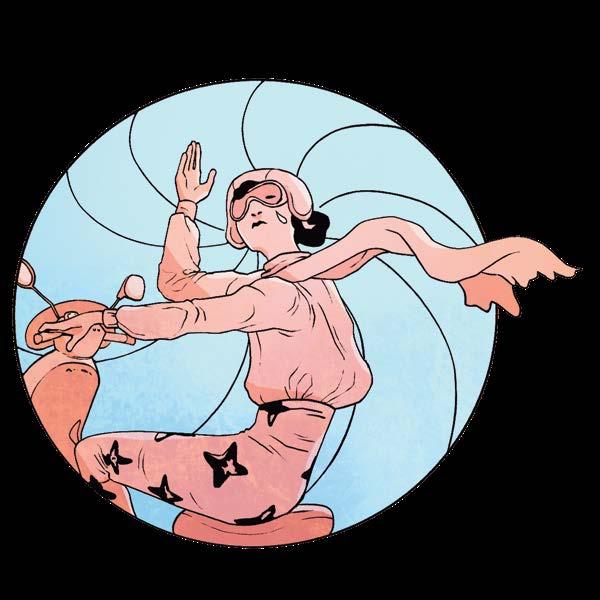
26 COMMUNITIES
Everybody, break the tissues out and get ready to cry. The beloved Reader’s Digest Canada is closing its doors after 76 years of production. It is a sad, sad time for Canadian readers.
Reader’s Digest first began in 1921, with its conception proposed by DeWitt Wallace. Originally intended to include condensed, easy-toread articles for its originally American audience, to which Reader’s Digest still serves today. In 1922, the first issues of Reader’s Digest began to arise, creating a new space for American readers, with the expansion of a Canadian branch, not far off. Wallace’s wife was a Canadian born publisher, originally from Manitoba. In 1938, Reader’s Digest expanded (yay!) to the U.K… (ah, the motherland, as to be expected.) The magazine would then go on to expand to 163 countries, including Canada in 1946. This first Canadian publication included a French-language edition, the magazine then expanded to English speaking Canadians in 1948, becoming one of the most influential and well-read magazines across Canada.
After a storied history with Canadian citizens, Reader’s Digest Canada will shut down in March of 2024, saying goodbye to its Canadian audience for good. The news of the publication’s ending was announced in a meeting with the Globe and Mail in attendance, to which they broke the news. As to be expected, the shutdown was caused by declining advertising revenue, rising production costs and a loss of readership. By November of 2023, 10 Montreal employees of Reader’s Digest Canada had received layoff notices, effective January 1.
While Canadians may remember Reader’s Digest issues as their preferred reading in their rural dentist office, or as the dated photo clips they’d cut out and elmer’s glue in elementary school, it was a brand we recognize, and grew nostalgic for. Reader’s Digest operated on an odd form of nostalgia, sure maybe you never read it, or cared much for the contents, but it was that recognizable face in the grocery aisle above the candy bars. It may have been the least compelling purchase, but it will feel like an odd blank space, crowded by E! and the People’s magazines once it’s gone. Gone… but not forgotten.
The readers may be able to bid Reader’s Digest Canada adieu but those who will pay the real price will likely be the many writers, editors, and journalists who’ve committed to Reader’s Digest for their underpaid, yet valuable steady jobs for these workers. Any journalist will be well familiar with the current state of Canadian journalism and the lack of jobs in this industry. For reader’s digest alone, by 2021 revenue shrank by half compared to 2013, and this trend has translated throughout nearly all Canadian publications with no end in sight.
In a quote to Montreal CTV news, the former owner of Reader’s Digest Canada stated, “it’s a crisis caused by our lack of interest in reading,” he said. “If people read more and got away from screens, they’d open up to lots of other things. That would allow a lot of publications to live. Maybe people would spend more time reading them than tapping away on their phones.”
Though, while this may be the opinion of some in the industry, the answer to revolutionizing the state of Canadian journalism may lie on the screens themselves.
27 COMMUNITIES

Where to go and what to do in Vancouver and the Lower Mainland
What Is In For This Year's Valentine's Day
CREW WRITER
LEA KRUSEMEYER (SHE/HER)
CREW ILLUSTRATOR
CHELLE LUSSI (ANY)

28 COMMUNITIES
With Valentine’s Day just around the corner, a sense of excitement can be felt in the Vancouver air. Newly in love couples looking forward to their first Valentine’s Day together and couples celebrating their tenth Valentine in love can be seen all over the city. Now, it does not matter if it is the first or the hundredth time that you are celebrating the day of love with your partner, the pressure to create a perfect date is on.
I am here to provide peace of mind and suggest some ideas and events happening in Vancouver around the time of the day of love. First, every day can be a day of love if you put in effort but around February 14, the lower mainland is full of events that elevate the date experience.
If you and your partner are crafty people who like to create and be creative, the Pacific Arts Market has just the right event planned. On the evening of Valentine’s Day between 7 p.m. and 9 p.m., they are hosting a Neon Paint Party at which you and your loved one can paint your heart away. Tickets can be purchased online for $60 each. The price includes painting supplies as well as an apron and expert guidance. Take your partner and create art that can be hung in your college dorm room as well as your future home together.
If you are the kind of person who enjoys dancing and music more than a laid-back night of painting, the Valentine’s Party at the Red Room might be just the event for you. The Red Room, which is known for its Latin music and great party atmosphere, is hosting this Valentine’s party with DJs from all over North America. Happening on February 15, this event is perfect for energetic couples who enjoy partying, or for all the single humans out there who just want to enjoy a night of dancing. Tickets are $35 and can be purchased in advance online.
Not every couple has the opportunity to spend their Valentine’s Day together and that is completely valid as well. or those of you who are doing long-distance relationships, there is always Teleparty. With this application, that can be applied to almost all common streaming services, you can watch a movie together even if you might be continents apart. A cozy night at home, spending hours on FaceTime with your partner while you are watching a Valentine’s movie can be just as romantic as a date spent together in person. Do not let the physical distance take away the magic of love.
The most classic of all Valentine’s date ideas would most likely be a romantic dinner, but if we are honest, not everyone is a great chef. Do not let your possibly lacking abilities to perfectly sear a steak hinder you from the experience of a romantic dinner with your loved one. At Langley Townhall, you and your partner can indulge in a three-course meal with wine pairings on the evening of February 14. For $60 per person, a night full of culinary excellence is guaranteed, and the best part of it is that you can enjoy without doing the dishes.
No matter if you are celebrating this year’s Valentine’s Day alone or with a partner, never forget to love yourself first. As RuPaul says, “If you can’t love yourself, how the hell are you gonna love somebody else?”
29 COMMUNITIES
Vancouver’s Black History Month
Origins, resources and events
CONTRIBUTOR
AYLA MAXWELL (SHE/HER)
ILLUSTRATOR
CASSANDRA VP (SHE/HER)
Black History Month takes place every February and is a time to celebrate the achievements of the Black community, educate ourselves, and think inwardly about what we as individuals can do to help achieve an anti-racist society.
The origins of Black History Month can be traced back to 1926 when Carter G. Woodson created a week to honour and learn about Black people in the United States. The week was celebrated in February to honour the birthdays of two important people in the history of the rights of freedom for African-American people: Abraham Lincon, the president who declared the “Emancipation Proclamation,” which freed all enslaved people in 1863, and Frederick Douglass, who was an activist for civil and women’s rights as well as was a huge advocate for the women’s suffrage movement. He felt that “Right is of no sex, truth is of no colour.” Douglass was an enslaved person during the 1800s. It wasn’t until 1977 that Black History Month became officially recognized across the United States.
Canada, however, took much longer to recognize the month. Many attribute the spread of knowledge about the month to Black porters, or employees, of the railways that crossed the American-Canadian border. It is believed that this group of African-Americans told Canadians about the celebration, which is how it came to be recognized in Canada. Although these stories of porters date back to the 1930s, it wasn’t until 1995 that the Canadian federal government instated February as Black History Month.
Now, in the year 2024, Black History Month is celebrated by dozens of countries all over the world. Each year, an overarching theme is chosen for the month. It varies from place to place, but in Vancouver, it was recently announced that the theme will be “Black Excellence: A Heritage to Celebrate; Future to Build.” It is to be expected that this
30 COMMUNITIES
theme will cover the history of the Black community in Vancouver and where it is going.
Kicking the events off, on February 1, the Surrey Arts Center is putting on a dinner and performance titled “Black In BC: Celebrating Black Excellence 2024.” Performances are set to include African dance, music, and a buffet. As well as a fashion show by Vancouver Community College and a panel where speakers will discuss the night’s topic: “Beyond Boundaries.” Tickets are free to anyone who reserves a spot.
On February 4, a market is opening in Richmond called the “Black History Month Pop-Up Shop.” As the title suggests, this market will host various vendors selling art pieces, food, and handmade accessories, all created by Black artists and business owners. An amazing way to show your support is by engaging with small bipoc run local businesses, so don’t miss out on this event.
Finally, on February 22, a concert to celebrate Black History Month is taking place on Commercial Drive. Tickets are $30 each and tend to sell out fast, so it is recommended to book in advance.
Another resource in Vancouver is the Black Vancouver Library, run by five young people of colour. The space is located in what used to be Hogan’s Alley, historically home to much of Vancouver’s Black community from 1923 to 1967, until roads and a viaduct were constructed through it, erasing the history of Hogan’s Alley, before it became a historical landmark. Today, Hogan’s Alley is made up of a border of Union Street, Prior Street, Main Street and Jackson Avenue on Vancouver’s East Side. As stated in
their GoFundMe, the Black Vancouver Library is a “space to not only to sign out books for free, [it is] intended to be used as a study space, a chill space, a safe space.” This new library is incredibly exciting because it is so vital for people of colour to feel like they have a safe space where they feel seen and represented, this is an especially incredible resource for youth. Noted in their GoFundMe, since the destruction of Hogan’s Alley, it has been hard for people of colour in Vancouver to feel like they belong in a community; the opening of this library lends the opportunity for these people to feel as though they have a space that was created especially for them in mind.
Not only is the Black Vancouver Library a great place to read and hang out, they also hold events like open mic nights, or ‘couch jams’ as they call them, which highlight talented BIPOC musicians in the community, these are said to be a space for R&B music mainly, but anything is welcome. They also host a book club, which anyone can drop in on. In the past, they have also hosted markets and cookouts. All of the information about their events can be found on their Instagram: @Vanblacklibrary, or on their website, which is coming soon.
Canada has come quite far in recognizing Black History Month, but much more needs to be done. It is so important that we all educate ourselves, attend events and amplify the voices of the Black community; if we do not, nothing will ever change. This Black History Month, be sure to make your voice and support heard.
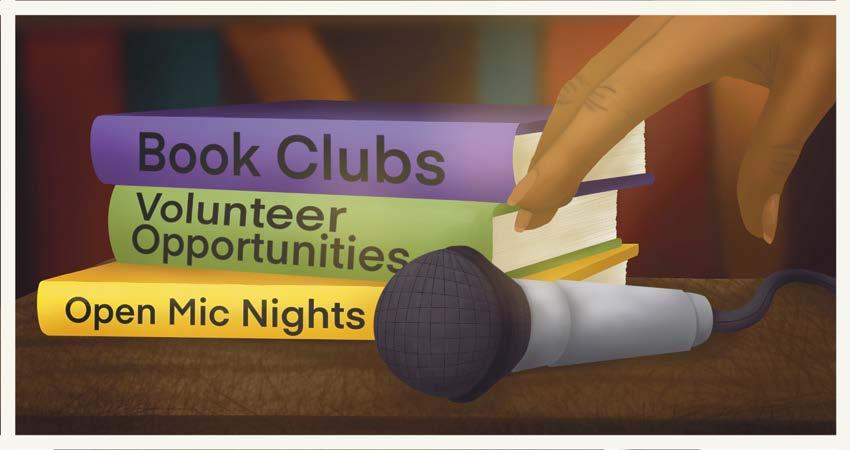
31 COMMUNITIES
Tinder, Grindr, and Co.—Stories straight out of hell

It’s been the reality of the past two generations to have horror stories when it comes to online dating. Like no generation before, Generation Z, which includes anyone from 1997 to 2012, has immersed itself into online dating. With a variety of apps and websites available, anyone can find a potential date online. The most common apps used are Hinge and Tinder, meanwhile gay men frequent Grindr and lesbians use HER.
Horrible pickup lines seem to be a common theme, especially within the straight dating scene, Andreea M. spoke about a time someone messaged her, “What’s for dinner tonight?” followed by a “ME-N-U.” That is not just uncreative but also unromantic and really takes the magic out of dating. A trending sound on TikTok says, “What happened to: hello, how are you?” which is commonly used by people who are sharing their unhinged encounters on dating apps. Weird conversations and dates seem to be a common experience in our generation.
While a pickup line like the one that was used on Andreea might be cringy but overall not harmful, there are other people out there who cannot say the same. Jonas K. claimed that body shaming is a commonly used method on Grindr. Just by looking at the pictures provided
A collection of real-life horror stories found on modern-day dating apps
CREW WRITER
LEA KRUSEMEYER (SHE/HER)
on someone’s Grindr account, other men feel the need to comment on a person’s body in a hurtful way. “You would be really attractive if you just weren’t that fat,” was a text that Jonas got one day. Comments like that can trigger people into eating disorders or other mental health problems. Worse still, they are completely avoidable. If you do not find someone attractive, just ignore the person and move on to someone with a body to your liking.
In person dates can be just as bad if not worse. Stefano Z. for example, once unknowingly went on a date with a married man. After texting with a guy online for a while the two decided to meet up for dinner, Stefano arrived at the restaurant at the arranged time, and when his date did not show up 30 minutes after the set time, he decided to text. He got a very apologetic reply with a promise that he would be there as soon as possible and to Stefano’s surprise, his date did show up about 30 minutes after that. He even brought flowers, which made Stefano believe that the date was off to a good start, but when asked about why he was one hour late the date mentioned that it was his wedding anniversary with his wife and he had to celebrate with her first.
This just raised a forest of red flags, first of all, who plans this badly? If you have to cheat on your wife, at least choose a
32
SEX


ILLUSTRATORS
FREYA EMERY (SHE/HER) ANDY POYSTILA (HE/HIM) ANGELICA BLANCH (SHE/HER)
day that is not your anniversary. Secondly, rethink your marriage so cheating won’t be necessary in the future. Lastly, he was a deeply closeted man who saw Stefano as someone he could see for fun but he would never be willing to openly stand up for their relationship. This might be okay for some people, but it should have been made clear long before an in-person date was arranged. Stefano did not feel comfortable being the hidden side piece and left the restaurant after that conversation, this could have been avoided if his date was just honest about the situation he was in.
Lying can also be a common occurrence in online dating. Sofia T. was chatting with a girl she liked who claimed to be 25 years old, which was perfect as Sofia was 27, and two years was an acceptable age difference for them. However, when she showed up for the date, the other girl looked completely different from her pictures, and far younger. This is a system used frequently called “catfishing” and the exact reason behind it stays hidden. Sofia’s date turned out to be 20 years old, and uncomfortable with their age difference, she left the date.
Saving the worst for last, situations in which you are being taken to an unknown location on your date. That happened to Yannis B. who once went on a date in New York City and was picked up by a guy who offered to bring him to his place. His place turned out to be a lovely property in the suburbs of NYC which Yannis
described as “a mix between a sex dungeon and a crack house, there was no light and no doors and people were doing drugs everywhere.” While Yannis was fortunate to be sober enough to leave and book an Uber home, not everyone might be that lucky.
When it comes to online dating, caution is necessary. Gen Z is smart when it comes to online behavior so most stories end up being fun anecdotes that can be shared at parties, but that might not always be the case. Be cautious and always trust your gut when it comes to navigating the online world.
Connect to these Canada-wide resources for support with sexual violence: https://www.reescommunity. com/resources/
33
FEATURES
ThirstTok With Thoren
Chopping out toxic masculinity one log at a time
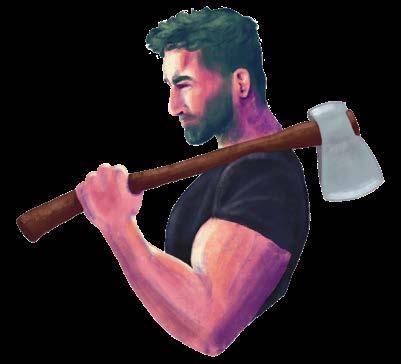
OPINIONS EDITOR
JAYDE ATCHISON (SHE/HER)
ILLUSTRATOR
VALENTINA KRUGLIKOVSKAYA (SHE/THEY)
When the world shut down, the masses turned to TikTok for an escape from the unprecedented reality that surrounded them. The algorithm brought content that made people laugh, cry, or in some cases drool. Beautiful people that were previously unknown began to cater to the desires their viewers may not have previously known they craved. BDSM point of views, posting glow-up transitions while lip-syncing seductively, or in Thoren Bradley’s case—looking good while chopping wood.
Bradley was no stranger to the struggles that came with the new way of existing when the pandemic hit. While working as a NCAA strength and conditioning coach, he experienced mistreatment from the higher-ups in the university he worked at. Instead of choosing to pursue his PhD in exercise physiology, he decided to step away from the higher education system and build a life on his own terms.
Growing up conventionally attractive, Bradley never struggled with self-confidence when it came to his looks. However, there always seemed to be an assumption about who he was upon first glance.
“When people looked at me, [they] thought they had me figured out before we had even spoken. It haunted me everywhere I went—I always felt like people were passing judgement or making assumptions about who they knew I was before I even talked,” said Bradley.
Having the feeling that people weren’t taking him seriously inspired him to pursue a career as a professor in order to prove to people that he was also an intelligent person. Walking away from the academic world was hard, as he felt like that was no longer a part of his identity.
Social media marketing shortly became the new way he began to showcase his intelligence. Bradley figured out what the masses wanted to see, and knew he could sell his brand with eye-catching content.
The 32-year-old had his first video go viral in February of 2020, in which he can be seen flipping chicken on his outdoor grill, shirtless with a great view in the background. The comments ranged from blatantly admiring his looks to trying to guess the ingredients used in his food. In the early stages of the app, TikTok did not pay its creators. However, Bradley did have a sponsor that saw his quick and substantial media growth and offered him
34 FEATURES
$1,000 a month to promote their product. This combined with his personal fitness app, he felt he had the financial space to figure things out.
Deciding how to draw in viewers wasn’t difficult for Bradley, as chopping wood is a regular occurrence in his life. His home uses a wood stove as its primary heat source. He didn’t have to change his lifestyle in order to create content that people wanted to see.
“There is so much of my persona and personality that I could share that would be interesting, but I’m just going to stay within the pocket of things that are easiest for me to film,” explained Bradley.
While many influencers may be looking for a moment in the limelight, Bradley tries to stay away from it. When one of his videos hits a hyper-viral level of viewership, he often feels exposed and anxious. “You know when you have a cavity and it hurts to drink cold water? That’s kind of how it feels…I never wanted or needed all of this attention, I did it out of necessity to get out of a career path that wasn’t working for me, so it’s been a necessary evil.”
He may not enjoy the feeling of videos that reach near the 10 million mark, he feels happy when others find success through his videos. He watches users with a small following duet his ‘thirst trap’ content and have a boom in their viewership or following. Realizing that his videos help bring comfort to others through monetary gain makes him happy.
To some, masculinity means taking control, puffing up your chest and showing bravado. To Bradley, masculinity means providing someone an arena to do what they want to do, safely. “The most genuinely masculine moment of my life was allowing my wife the space to do whatever the hell she wanted to do for a living.”
Having a page where many people are admiring one’s physical attributes could easily put a strain on a relationship, but that doesn’t seem to be the case in Bradley’s marriage. He advocates for total transparency, shared decision making, and ensuring she is included in every part of the process.
“If there’s a business opportunity, it’s a no if she’s not allowed to be involved. If they won’t fly her, I’m not going to leave her. The whole reason I started doing this was to be independent so I could spend more time with my loved ones—I’m not going to go backwards now.”
What began as an advertisement to draw people into the real Bradley, turned into a realization that the videos were opening up a dialogue about the things that turn viewers on, or what they’re attracted to, in a way that people haven’t always been able to speak about openly.
However, with sexually appealing content comes flak from many viewers. Bradley will often post videos replying to angry viewers firing back against toxic masculinity and trolls putting the videos and viewers down. An observation of not only social media, but society as a whole, Bradley points out the attempt to dismiss anything that women enjoy.
“It’s an attempt to shame what women are interested in,” said Bradley. “[Men] have to find something to reduce the value of whatever the content is, or else the bar continues to be raised.”
Utilizing his physical and intellectual strengths in the ‘ThirstTok’ sphere, Bradley has created opportunities for the kind of freedom that he wants. Between reviewing axes, workout drinks and splitting wood in the forest, Bradley shuts down the toxic comments through insightful replies.
“I wonder how different our consumer culture would look if


35 FEATURES
Sex Sells

Unveiling the liberating effects of virtual platforms in an ever-evolving sexual marketplace
CONTRIBUTOR
ILLUSTRATOR
36 FEATURES
MIKAILA POIRIER (SHE/HER)
JASMIN LINTON (SHE/HER)
“The beauty of online sex work is that it cuts out the middle-man and puts the power back into the hands of the worker”
In spite of the endless string of laws and shame-based societal beliefs that have worked against it for centuries, sex work has evolved into one of our generation’s most viable career options. Although the stigma around the profession can still be felt, the cultural perception of sex workers has shifted significantly in the virtual age; what was once considered too taboo to be discussed openly in mainstream media is now a defining part of it.
The relevance of sites like OnlyFans in the cultural zeitgeist is slowly nudging society towards a future where sex work can be spoken about without any harmful preconceptions, thus allowing us to effectively address the safety and accessibility issues in the industry. While we have yet to see any updates in government legislation that reflect the needs of sex workers, the internet has been an essential tool in bridging that gap.
The importance of these advancements has been made especially apparent in the past four years. Lockdowns in 2020 meant in-person sex workers lost their primary income stream without warning, and government support was often difficult to seek out without putting themselves or their clients at risk of facing legal consequences.
Moving their services to a digital space was the only option, but many saw the benefits of remote work quickly and decided to stay there. The beauty of online sex work is that it cuts out the middle-man and puts the power back into the hands of the worker, and flexible labour allows those with disabilities or chronic illnesses to address needs that are often overlooked in the job market. Although profiting in the sex industry takes effort, there are fewer barriers for those in marginalized groups or at a financial disadvantage than in many other lines of work. In a post-pandemic economy, more and more people have turned to online sexual commerce to make ends meet, and for many, it’s working.
Virtual sex work has existed since the inception of the internet, but a wave of modern platforms have transformed it into a flourishing marketplace. The options are seemingly endless, and the variety of semi-regulated sites out there means anyone with the right drive can earn money with minimal risk compared to just a few decades ago. The most infamous of these sites is the aforementioned OnlyFans, a platform that was inherently anti-sex work even before they banned porn. Thankfully, the reinvention of the site only motivated its users to seek out better alternatives, such as ManyVids; a femme-owned Canadian platform favoured by adult entertainers and webcam streamers for its feminist and LGBTQ-inclusive practices.
For a more niche target audience, certain sites allow people to explore kinks like financial domination or pre-worn panties. The former is a relatively exclusive market that can be hard to break into, while the latter is quite easily accessed through websites like Panty Trust. Here, where anonymity is common, success is especially dependent on effective marketing practices.
This process will often surprise many people looking to break into the industry, as this type of work has garnered a false reputation for providing quick cash with minimal effort. This belief, however, is far from accurate. To be a sex worker is to transform yourself into a business, and the knowledge that it takes to do so only further legitimizes sex work as a real and respectable career.
37 FEATURES
The validity of the sex industry can also be recognized in its longevity. Prostitution is colloquially referred to as ‘the world’s oldest profession’ for a reason. Yet, traditional forms of sex work are far less relevant now that the internet has taken over, and there are arguments to be made for whether or not this is a good thing. The most obvious advantage of working virtually is the improved safety features.
Many sex workers still provide in-person services, of course, but they’re able to thoroughly research their clients ahead of time to ensure that they know who they’re meeting. Removing the internet as a factor in these exchanges can result in working conditions that are unpredictable, unregulated and potentially dangerous. Given that providing sex workers with protected workspaces or forms of security is still illegal in B.C., online spaces often end up being the only option for a safety buffer.
Once a screening process is established, though, traditional sex work certainly has its perks. It’s far easier to build a regular clientele this way, as providing online services can be impersonal. There’s also the element of pleasure, as many sex workers are naturally motivated by things other than just financial gain. For those who prefer physical connection, traditional sex work is more fulfilling. However, this seems to be less of an issue in the modern landscape of the industry. With increased control and accessibility, all from the comfort of your own home, it’s hard to see why virtual sex work wouldn’t be taking over.
The internet has contributed to the boom of the sex work industry in a multitude of ways. Beyond the improved working conditions that it provides for sex workers, the option to remain anonymous online has made sex work seem even more appealing for both parties in the exchange; femmes on Twitch can get paid for streaming themselves in a bikini from the shoulders down, while wealthy, reputable clients can choose to hide their identity behind a screen. The process is wellstructured in the pursuit of avoiding shame, but the real objective should be to continue reshaping a culture where sex and the human desire for it isn’t seen as shameful.
It’s refreshing to witness the strides that modern sex work has taken towards achieving this goal. The internet has allowed a subculture of sex work advocates to unify, and as a result, mainstream media has never been more sex-positive. Although Western society should ideally be further ahead by now, at least we can say that we’re moving in the right direction.
38 FEATURES


39 FEATURED ARTIST
Cameron Skorulski (he/him)
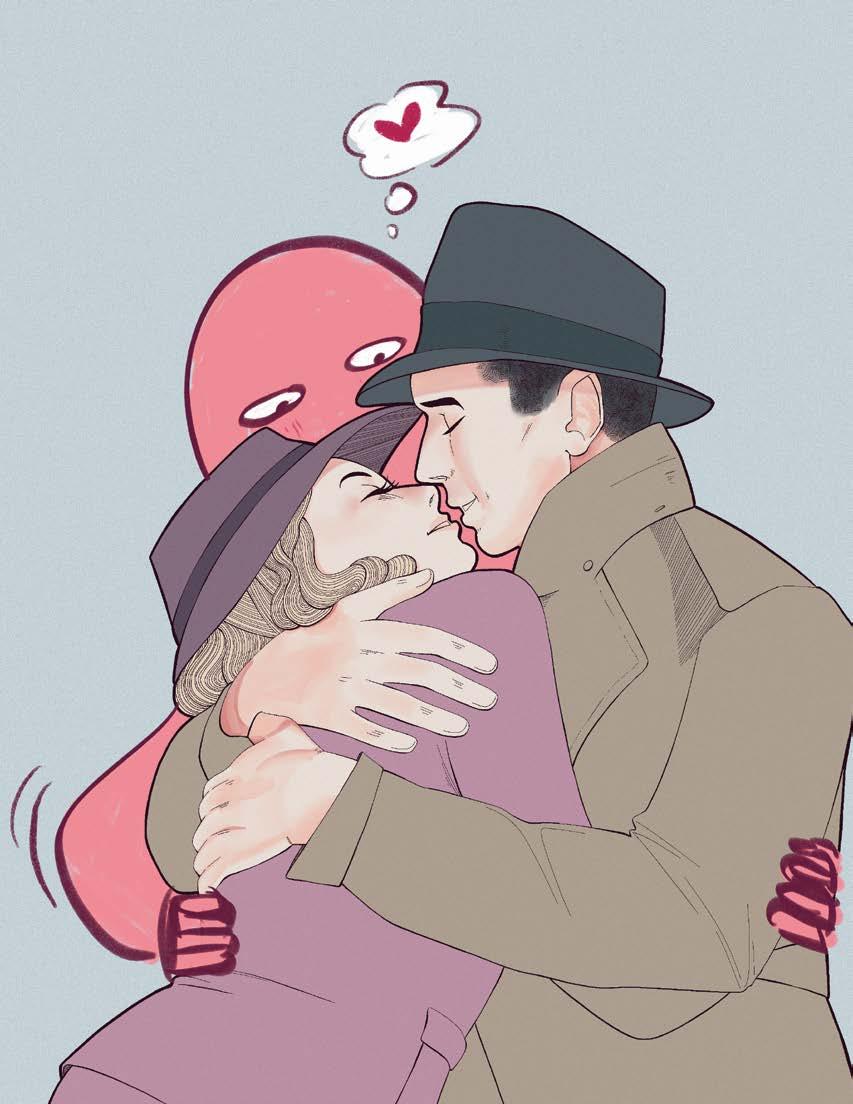
Coordinating Consent
40
SEX
The emergence of the intimacy coordinator role in film and TV
CREW WRITER
KIRSTEN WILTSHIRE (SHE/HER)
ILLUSTRATOR ALINA SANDU (SHE/HER)
“The number one thing is that everybody feels safe, and that they have consented to what’s going on,” says P. Lynn Johnson, an intimacy coordinator, actor and instructor at Capilano University. “The intimacy coordinator is the advocate and the go-between. So that the actor doesn’t have to say, ‘I’m not comfortable with that’.”
An intimacy coordinator (IC) on film and TV sets ensures the emotional safety, comfort and communication of the cast and crew. They coordinate physically intimate scenes between actors or scenes involving nudity or even violence. They bridge the communication gap between the actors, the director and the crew. The goal is to make informed consent a cornerstone of vulnerable scenes. The IC can make suggestions and tweaks, essentially choreographing simulated intimacy safely while maintaining authenticity in the scene.
ICs go through various levels of training along with hands-on industry experience. ICs and intimacy directors must acquire certification through a SAG-AFTRA accredited program, such as “Intimacy Directors and Coordinators.”
The role of IC originated from the theatre, where practitioners are called intimacy directors. The Weinstein scandal in 2017 exposed the grave lack of emotional and physical safety within the film industry, showing a dire need for advocates of actors in vulnerable positions. The emergence of the #MeToo movement, started by Tarana Burke, highlighted the breadth and depth of the issues associated with informed consent and lack thereof on set. At the time, the industry didn’t have appropriate or effective safeguards for actors on or off-screen. Enter Ita O’Brien, pioneer of the IC role. In 2014, O’Brien developed and adapted the role of intimacy director (from the theatre) to intimacy coordinator (specifically for film and TV). She wrote the first industry-standard guidelines for scenes of intimacy in the film and TV industry. In 2018, HBO committed to having an IC on all projects that included intimate topics or scenes, setting a precedent for the industry.
Johnson described a regular series of events as an IC. After receiving a request to join a project she receives the script, where she gets context about the scene from the director. Her job is to understand the director’s vision so she can appropriately choreograph the scene. Then she’ll reach out to the actors and go through the scene with them together and individually to discuss logistics, scene specifics and boundaries. She then confirms with the director that the actors are ready for, informed about and consent to the scene. “We talk about a safety word. Somebody could get a cramp in their leg, and we have to stop or [say] ‘tomato, tomato, tomato!’” explains Johnson.
She makes sure the wardrobe department is able to provide all of the right garments, such as shorts, special undergarments or tape. She’ll then write a risk assessment of the scene and get a rider—a legal document stating the performer’s requirements for the scene—in place. The scene is shot with the IC on set adding input, notes or communication between actors and the director. A day or two after the shoot, she reaches out to the actors and checks in regarding the scene. To tie it all up, she writes a production report so there’s a record of it.
Johnson says, “it’s to just really have clear, clear paths of communication so that on the day, in the moment, the actors can be fully engaged and not secondguessing themselves.”
41
ARTS & CULTURE

The Mythical Origins of the Vibrator
Many think they know the story, but the truth is a bit more complicated
KIRSTEN WILTSHIRE (SHE/HER)
42 ARTS & CULTURE
CREW WRITER
CREW ILLUSTRATOR CHELLE LUSSI (ANY)
Sex toys have been a part of the human experience for a long time (like, really long) with the first phallic artifact dating back to around 28,000 BCE. It’s not confirmed that these dildo-like stone, clay or wooden creations were specifically used for sexual acts, but it’s not not confirmed. Over thousands of years, these ‘tools’ progressed and appeared across different cultures worldwide, from ancient Egypt, Babylon, Greece, India, China and the Roman Empire. The technology remained fairly rudimentary until the 19th Century, when the vibrator was created, signaling a huge advancement in pleasure.
It all starts with hysteria. The concept of hysteria as a psychological disorder (more of a demonological belief at its origin) dates back to the era of ancient Egypt. Any person with a uterus was susceptible to this disorder, as the cause was believed to be the mere presence of a uterus. It evolved to be a catch-all term for any disruptive behaviour that women expressed. The story goes that in the 19th Century, doctors would clitorally stimulate women with hysteria to achieve a ‘hysterical paroxysm’ which included heavy sighing, moaning and full-body convulsions…so, an orgasm. In the 20th Century, hysteria was treated with the use of the vibrator as a relief for doctors’ weak and fatigued fingers.
According to pop culture folklore (such as the film Hysteria and the play “In the Next Room”), women would feign a hysterical flare-up so that a medical professional would use a vibrator on them to induce hysterical paroxysm. It was spun as subversive empowerment for women; you go to the doctor, tell them you’re losing your marbles, get access to a vibrator to blow off some steam and no one is the wiser. But here’s the rub; the origin story is a myth.
The popular story originated from a book titled The Technology of Orgasm by Rachel Maines. Maines took liberties when she hypothesized about the use of vibrators for hysteria. Hallie Lieberman, a sex historian at Georgia Institute of Technology, reviewed each of Mainse’s primary sources in the Journal of Positive Sexuality in 2018. Lieberman found no evidence that vibrating machines were used clitorally, or that they were used to treat hysteria. Vibration was used in the medical industry to treat an array of ailments such as pain, deafness, spinal disease or even constipation.
So no, there is no evidence that doctors were helping women masturbate as a treatment for hysteria. It is, however, true that vibrators and vibrating machines originated from the medical industry and that vibration was used as a treatment for different ailments, such as menstrual pain and uterine prolapse. In the early 1900s, vibrator technology had progressed to a smaller and more portable appliance, and they became regular household items. Think of it as an early 20th-Century thera-gun.
But sexual pleasure, especially for women, was seen as debaucherous and obscene and their absorption of the vibrator as an erotic tool outweighed other marketable medical qualities of the vibrator. The household vibrator was adopted by women as a sexual toy, making it hard for makers of the appliance to continue marketing it as anything other than a tool for female pleasure. The risk of lascivious association with the vibrator was too powerful.
43 ARTS & CULTURE
Drag Kings and Things of Vancouver
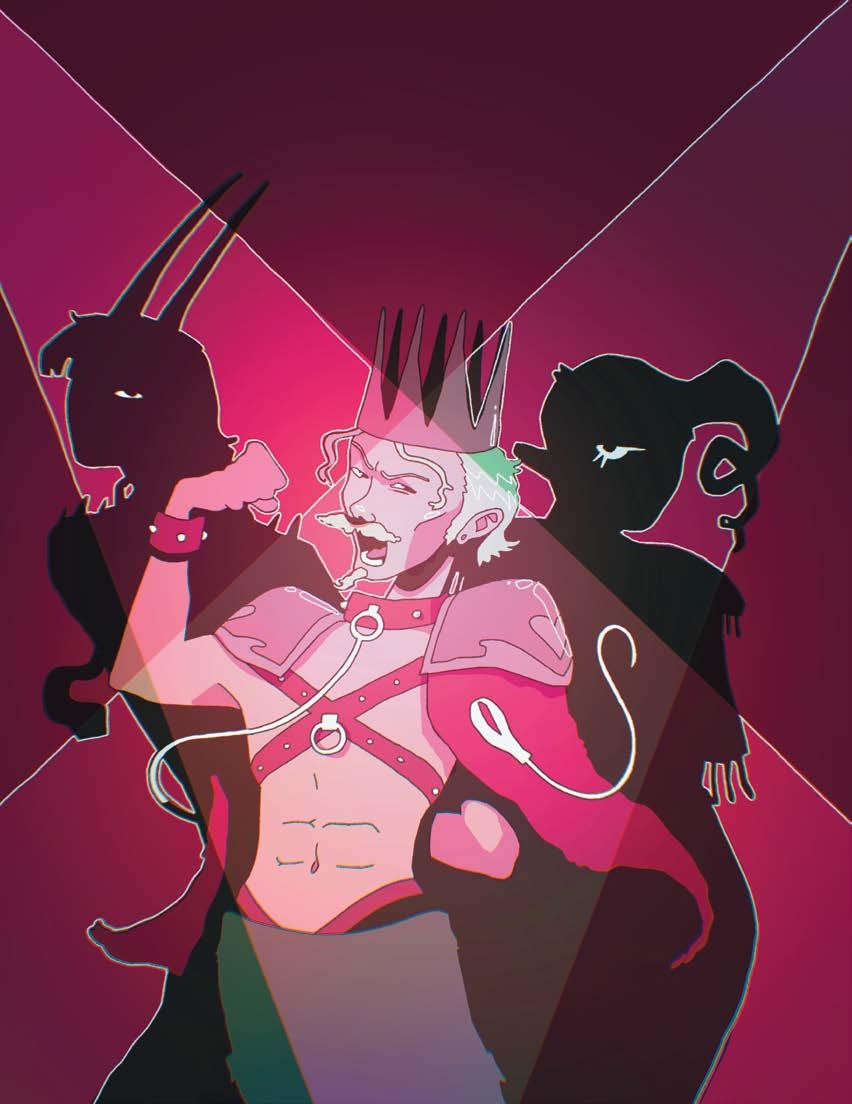
Drag is a huge part of Vancouver culture, but drag queens are not the only performers around
ARTS & CULTURE EDITOR
GWEN PEMBERTON (SHE/HER)
ILLUSTRATOR BELLS WHITE (THEY/THEM)
44 ARTS & CULTURE
Drag is an integral part of Vancouver culture. Particularly in the Davie Village neighbourhood, the impact that drag and drag performers have had on the city is impossible to miss. Walking around town or talking with friends, it’s easy to find great shows and events featuring drag performers, especially if you follow a few online. There is also, however, a part of the community that is significantly less visible.
Drag kings and drag things—the name for non-binary performers— are much harder to find than drag queens if you don’t know where to look. Drag kings are the opposite of queens; they are people who embody exaggerated forms of masculinity. Cursory Google searches for non-conventional drag in Vancouver don’t often provide people who are interested in drag, or simply want to see a show, with a lot of options.
One name that does pop up is Justin ABit, a prominent drag king performing in and around Metro Vancouver. Justin has been performing since 2019. By 2020, he became a co-winner of the King and Queen of Hearts Pageant, a yearly charity event held at The Junction in Vancouver. ABit also performed at Commercial Drag, a prominent show which was hosted by the performer Dust, who was looking to fill a gap that they saw in the Vancouver drag scene for non-conventional performers.
“It was where so many people started, and it was very much a king/ thing extravaganza,” says ABit. But this was all in the beginning of 2020. “I did my second show [at Commercial Drag] and then literally a week later…the pandemic happened.”
That was far from the end for ABit though. In 2021, he was featured in the second season of the popular drag contest show Call Me Mother, where he made it to the final five. Off of that success, Justin has built a strong online presence and become a recognizable face in the community, especially with his signature sparkly blue chin strap.
“I guess people are calling me an elder king…I would call an elder king somebody that’s been doing it for ten, 15, 20 years. Because I know those kings, they still exist in the city,” says ABit.
One such king is the first that ABit ever saw perform, Ponyboy. They are one of the longest established kings in the Vancouver area, and an organizer for Man Up, a popular drag show that is not afraid to blur the lines of gender.
Man Up remains a popular option for those who are interested in non-conventional drag. There are also various other events featuring drag kings and things, including King Sized at The Birdhouse, featuring a diverse group of new and notable performers. The next King Sized event will be held on Feb. 9, 2024. Willow’s Wild Things, hosted by Willow Child at The Junction is another fantastic option. For those curious about drag,The Junction is a venue spotlighting many different kinds of performers. “It’s got great sound, lighting, space…It’s the stage in Vancouver,” says ABit.
Some other events to keep on the radar are Drag Attack and burlesque shows at the Rio Theatre. According to ABit, many performers cut their teeth in the burlesque scene before transitioning to drag. ENBY 6 is a “non-binary supergroup,” performing weekly at The Junction.
The best way to stay in the loop, if you are interested in getting into drag or finding new shows, is to follow performers and venues. It’s a great way to stay up to date, and for students there are often ways to attend shows for free or reduced rates. As ABit says, money is rarely a barrier to entry. “A lot of us will offer to buy tickets for people if they can’t afford to take themselves, just to make sure that that space and that show thrives,” he says.
Students can also enquire about opportunities behind the scenes, such as volunteering backstage or helping to collect tips. For people curious about getting into drag, ABit says that attending shows is the best way to connect with performers and make connections. Reaching out online has its place, but an in-person introduction is the easiest way to open doors.
For ABit and many others, drag is a form of liberation. “When you’re in full drag, with makeup and the big wig and everything, it just transports you… That’s a hundred percent.”
This month you can see Justin ABit at the charity show Queens Care on Feb. 24, 2024 at The Fountainhead Pub. The event is a fundraiser for the Black Therapy Fund Foundation. He will also be hosting Drag Bingo with Heart on Feb.11, 2024 at Bimini’s Pub & Lounge, fundraising for Rainbow Bridge.
45 ARTS & CULTURE
Love and Other Vices
A Short Guide to Some of Vancouver’s Sex Shops
CONTRIBUTOR
ASHLEA MCRAE (SHE/HER)
CREW ILLUSTRATOR ANDY POYSTILA (HE/HIM)

46 ARTS & CULTURE
In the age of the internet, it is easy to find everything you need on the web. This means that many turn to the internet for things designed to meet their most intimate needs. As we become more reliant on big corporations, local sex stores are losing foot traffic and becoming scarcer. You might even wonder why you should consider shopping at a local store when you can just order something online and have it delivered in discreet packaging by tomorrow.
Luckily, we’ve visited a ton of sex shops—so you don’t have to. Unless you want to, of course. Each offers a unique, catered experience with various levels of affordability and information, as well as providing the opportunity to explore and learn more about Vancouver.
Little Sister’s Book and Art Emporium
1238 Davie St. #1
Located in Vancouver’s most influential LGBTQ+ neighbourhood, Little Sister’s Book and Art Emporium is a historical hotspot for queer literature, advice and information, erotica, adult toys and supplies, as well as a fantastic greeting card section. Davie Village, where this shop is located, hosts the annual Davie Street Pride Festival which runs in conjunction with the Vancouver Pride Parade. Throughout the rest of the year the beautiful artwork, fun shops, and delicious restaurants that decorate this neighbourhood make for a great visit. This little store is open seven days a week, has free parking behind the store, and is a friendly and non-judgemental option for people of all communities.
Honey Gifts
350 Water St. // 3448 Cambie St.
With two locations in the Vancouver area—one located in Gastown and one in Cambie Village—Honey Gifts offers a boutique experience with a wide selection of adult toys, kink-specific supplies and lingerie. Both locations are surrounded by great shopping opportunities and tasty bites to eat, and are easily accessible by transit. While slightly higher in price, the quality is reflected in the products. They even have the option to book a private shopping experience, for those who really value privacy.
Womyn’s Ware Inc
896
Commercial Dr.
This little shop on Commercial Drive is a woman-owned and operated business that specialises in the empowerment and celebration of women’s sexuality. The shop welcomes all genders and seeks to celebrate those who want to explore their sexual expression in greater depth than what is typically represented in mainstream media. Commercial Drive is a lively and diverse area that is also home to Vancouver’s Little Italy neighbourhood. There is a lot to see and do in this area throughout the year, and it is easily accessible by transit for your convenience.
The Art of Loving
369 W Broadway.
Easily accessible by transit, The Art of Loving is located just a short walk from the Broadway-City Hall Canada Line SkyTrain station. This shop has everything you would expect, and they also host educational seminars for those looking to learn more about different sexual subjects. You can also find links to an informative blog and newsletter on their website. If you are looking to learn more in a safe and supportive environment, or pick up something fun to try, The Art of Loving is a great shop to check out.
Deadly Couture
1599
Venables St.
Deadly Couture is a fetish and alternative clothing company located on Venables St. in Vancouver. They have a great selection of latex, leather, corsets, gothic daywear and other statement pieces for all kinds of bodies. There is a wide range of pricing for all budgets, but what really makes this shop stand out is the curated experience it offers. You would be hard pressed to find a shop with as many options for fetish and alternative clothing as Deadly Couture. This shop offers curbside pickup for online orders as well as showroom shopping if you prefer to see clothing in person before purchasing.
47 ARTS & CULTURE
“Sunday Funday”

48 FEATURED ARTIST
Angelica Blanch (she/her)
Annika Yi (she/her)

49 FEATURED ARTIST
Sex Onscreen
Ever felt your trauma heal itself at the cinema?
CONTRIBUTOR
JASMINE GARCHA (SHE/THEY)
ILLUSTRATOR
JJ ENG (THEY/THEM)
SEX
50
Out of all the representations of sex onscreen, we can probably agree that many of them are negative or even triggering. Some are just plainly inaccurate or extremely exaggerated (we all saw Sex Education, right?) but some do well depicting certain themes pertaining to sex and relationships.
Something I find interesting is that the worst representations of sex onscreen always tend to be the ones aimed at teenagers; shows like Sex Education, Riverdale and 13 Reasons Why. Although, out of all the things that 13 Reasons Why did wrong, Hannah and Zach’s relationship was something done right. We saw enthusiastic consent from both sides and it began with a conversation. However, this storyline was done retroactively and seemed lazily thrown into the show.
I enjoy relationship and sexuality plots that have been planned and fleshed out throughout a series or film. When each plot line seems intentionally written to tell the larger story, it makes for a better watch. That’s why I loved the film Poor Things, which was based on the Alasdair Gray novel.
I watched Poor Things twice in theatres. It has a great representation of sexual liberation by following Bella Baxter, a woman with the brain of an infant (surgically speaking). Bella has been sheltered her entire life, so along with being mentally immature— because she is quite literally a child in a woman’s body—she is also undersocialized. As she explores and sees the world, she matures and grows in mental age.
The movie depicts how men see women from multiple perspectives. There’s Godwin, who “created” Bella’s developmental handicap through surgery. He has considered her a sexual being, but is impotent so he chooses to take on a father figure role. If he could have sex, would he take advantage of her? It’s not explored, but implications are made.
There’s Max, who knows Bella’s mental age, yet still wishes to marry her. He says he will not lay with her until after marriage… but he still intends to do so. He is a “nice guy” for show.

There’s Duncan, who doesn’t know Bella’s mental age, but senses she is different and takes advantage of this fact. We also see the Madonna-Whore complex take form in Duncan, as he becomes hateful toward Bella the moment he finds out she has slept with somebody else.
The movie even explores women’s internalizations of these outside perspectives. We see this with Madame Swiney, who runs the brothel, when she tries to justify Bella’s discomfort, “Some men enjoy that you don’t like it.” She also implies that a lack of gratification is what makes women whole.
Despite it all, Bella recognizes the importance of her own gratification and individualism. As Bella matures, the film modernizes alongside her; this is shown in the dialogue, the humour, and the film’s change from black and white to colourized upon Bella’s first time having sex. It continues to become more saturated in colour as she learns more about herself, the world around her, and how she, as a woman, is viewed in that world.
Maybe I didn’t write about the steamiest sex scenes I’ve seen, but maybe I just don’t know what sex is. What I do know is that I enjoyed watching Bella gain independence and a sense of self. I enjoyed seeing her decide that her body and mind are hers to nourish. The movie showed a daring representation of how men view sexuality versus how women do.
Also, I do not recommend sneaking rosé spritzers into the theatre to watch Poor Things. That’s not allowed and you can’t do that. Don’t do it.
OPINIONS
51
Three Date Theology
Girl math has nothing on dating math
OPINIONS EDITOR
JAYDE ATCHISON (SHE/HER)
ILLUSTRATOR
NATASHA LEE (SHE/HER)
52 OPINIONS
I stare at myself in the mirror, unhappy with the one hair that won’t sit the right way, mad that my outfit doesn’t look like it did in my mind and wondering if the person I’m meeting will look anything like their pictures. Even after dating consistently since I was 17, my first-date jitters still take over my day. I know this is a common feeling among daters—wondering if this will go well, if this will just be a funny anecdote at future parties, or whether it could be my last first date. This is not even including the stress that comes with trying to decide when it’s okay to have sex.
As a cisgender woman who dates men, there is an added layer to the navigation of sexuality online. Movies, magazines and television showcase the importance of not having sex on a first date. The narrative seems to be that men will sleep with you, but they will not take you seriously or think you worthy of pursuing any further. However, if you don’t sleep with them, they’ll think you’re a prude and will find someone else who is more open to sex right away. This is not the case for every woman or man, but it has been a drastically large part of my social upbringing.
The most common advice I remember receiving through real life and the media I was consuming was to wait until the third date to sleep with someone. You’d get to know if they were interested in you more than your looks, you’d see if you actually liked them, and it would feel like you were more in control of the situation. There are dating coaches on TikTok that are currently advising for a three-month no touching rule. No kissing, no petting, no sex.
Unless the abstinence is due to religious reasons, sticking to a strict timeline for sex is bullshit. It feels like you’re testing your potential partner for the wrong reasons. This isn’t Lent—if you want to have sex with someone, and it’s consensual, then just go for it. If the person wants to pursue you past a first, third or seventh date, they will—the act of sex will not be the sole factor.
It shouldn’t be up to a random math equation on when is the perfect time to dip your toe into intimacy (if that’s your thing, no judgment). It should happen when you and your date are both feeling it and want to equally explore things farther. Whether it’s your first time meeting someone or your sixtieth, you should be the one dictating your sex life—not society.
I can preach sexual freedom until my face turns blue, but unfortunately, society still has the little problem of double standards and slut-shaming. If a woman chooses to have sex (arguably before marriage), she is a slut. For a few men still out there, any “body count” is too high of a number. If a man does however, he is practicing his god-given right as a warm-blooded man.
Thankfully there are still many insightful people that don’t hold this archaic belief. Have sex, don’t have sex—it’s not up to anyone else but you. You will find a partner who will fit your chemistry, your needs and your thoughts on intimacy. Keep searching, go on dates and if it’s something that aligns with you—be a slut (or do whatever you want).

53 OPINIONS

Battle of Bookstagram

To be spicy or not to be—that’s definitely what Shakespeare had in mind

OPINIONS EDITOR
JAYDE ATCHISON (SHE/HER)

ILLUSTRATOR
YOHAHNAH LOKER (SHE/HER)


Romance novels can sometimes get a bad rep from, let’s face it—the snobs of the reading community. It seems like their idea of romance is the harlequin novels with Fabio and his hair flowing on the cover—although there’s nothing wrong with enjoying those novels either. The romance genre has always been there, but as the years go by, the bigger the variety of styles seems to grow. The biggest debate between readers on Bookstagram seems to be which is the better read—tame, tension-building romantic tales or raw, sexual and often kinky novels.
I like my books to make me feel something when I am reading them—the best books I have read made me cry uncontrollably, laugh out loud on the bus, and physically cringe out of disgust. If I don’t have some sort of bodily reaction from the book I’m reading, then I don’t consider it a very good read. So when it comes to the romance books I have read, a higher level of spice piques more of an interest.
Yes, there is something to be said for the Bridgerton type of books that get readers excited through a longing look or a touch of the hand—the build up is enticing and what makes the book stand out, eventually leading to a hit television series. However, the enemiesto-lovers sexual tension and inevitable intercourse that follows is something that cannot be beat. The most talked-about series with a level of spice that doesn’t define the book (like Fifty Shades of Grey), but keeps the reader engaged in the sexy moments between Feyre and her partners is the ACOTAR (A Court of Thorns and Roses) series.
54 OPINIONS
Depending on what your level of comfort is with sexuality—talking about, reading or listening to— the ACOTAR series is a fun fantasy with battles and adventure in between the sexier moments and a good intro to the spicy romance genre. It’s consensual, doesn’t discuss anything that might be triggering, and not hard to follow along with (I’m looking at you, J.R.R. Tolkien). Plus, Rhysand is a total babe.
There should be no shame in reading something with an explicit story arc—HBO is a success for a reason. Sex sells and people will indulge in spicy culture if it’s offered. There is not nearly as much flak given to those who watch Game of Thrones as there is to those who read “smut”.

It’s healthy to activate an interest in the sexual realm outside the real world. Reading spicier books can open an avenue of interest you may not have ever known you needed. There’s a chance you can learn something about your sexuality, preferences or desires you have yet to unlock.
I also encourage discussion between friends or book clubs, because a lot of the time we repress the topic of sex and this can create a lot more shame around sex itself. This could hopefully draw people away from
harmful porn or feeling like they can’t be honest with their partners about what pleases them. Yeah, I said it—spicy romances could save relationships (for legal reasons, this is not sound advice).

Ultimately, I think as long as you’re enjoying what you’re reading, that is probably the best genre for you—but be willing to branch out and try something new. Read whatever the hell you want and don’t let other people (read: snobs again) make you feel less than for liking any certain genre. Whether you’re into kinky Fae porn or Jane Austen-level modesty, there’s no wrong answer—be proud that you’re getting pages read at all.




55 OPINIONS
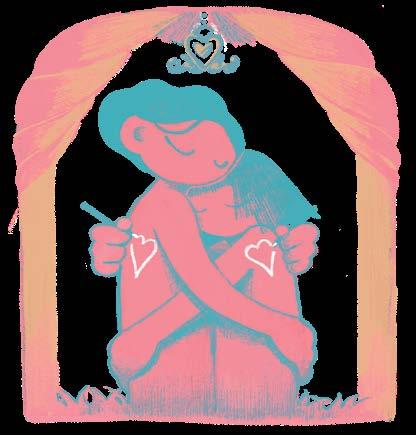
TouchingTacky or
Why couple tattoos are always a bad idea
CONTRIBUTOR
MIKAILA POIRIER (SHE/HER)
ILLUSTRATOR
SOL YOON (SHE/HER)
56 OPINIONS
I have a friend who recently got into the business of tattooing and when I asked her how it’s been so far she sighed and said, “Lea, I just can’t handle all these couples anymore.” That led to a highly amusing 30-minute conversation about some of the worst couple tattoos she had to do over the short span of her tattooing career.
It all started with a couple in their early 20s who came to her shop one day to get matching rings. At first, she thought they might be in the wrong shop, but it turned out they wanted tattooed rings instead of physical jewelry. Their vision was to tattoo each of their ring fingers with the date they met. After confirming that they were indeed of age and sober, my friend got to work and tattooed their desired project. Trying to make small talk to make the customers more comfortable, she asked what the reason behind their tattoos was and the couple said, “we just know we will stay together forever, so a [real] ring does not feel permanent enough for us”.
While my friend was maintaining a professional attitude towards the customers, she told me that she internally lost it when hearing this story. She and I are both in our mid-20s and we have seen enough “forever” relationships fall apart to know that that was just a horrible idea. For the sake of gaining experience, she currently rarely says no to a tattoo, and that led to her tattooing couple rings, names of partners, ship names of couples, the coordinates of someone’s first date and to top it all off, the logo of the motel in which a couple lost their virginity.
The human prefrontal cortex, which is responsible for processing the pros and cons of situations, does not fully develop until the age of 25. Any life-altering decision made before that age has a higher possibility to be regretted in the future. Of course, we have to make some life-changing decisions before we turn 25—for example, what our degree or our career should be—but those can potentially all be reversed. A tattoo is a lifetime commitment, since even with laser removal a scar will stay behind.
As a person in my 20s right now, I can assure you that my life right now looks vastly different from what I thought it would look like three years ago. If I had gotten a matching tattoo with the girl I was seeing in 2021, I would have a lot to regret now. We broke up and are no longer on speaking terms. There are no hard
feelings, but our lives just went separate ways. If I had the “ship” name the two of us had at the time tattooed somewhere on myself, I not only would have a lot of explaining to do to future partners, but it would also just not make sense anymore.
Now, I do understand the appeal of a sign of eternal commitment to your partner. I also understand that couples who have been dating for thirty years might be in a different position than people who just got together and are still wearing their rosecolored glasses. There are, however, many other ways of showing your commitment to your partner that do not include altering your skin. Get a star named after the two of you, get promise rings and engraved necklaces, or adopt a turtle and give it the day of your first date as a name. In 2024, there are just so many alternatives to show your love for your significant other than permanent ink. I believe we can agree that matching couple tattoos are tacky, not touching.

57 OPINIONS
neutral nudes
Put those pictures in the hands of those that will appreciate it most.

OPINIONS EDITOR
JAYDE ATCHISON (SHE/HER)
ILLUSTRATOR
CAMERON SKORULSKI (HE/HIM)
58 OPINIONS
After getting out of the shower and while picking your outfit for the day, you catch a glimpse of yourself in the mirror wearing a cute matching bra and underwear (because you finally did laundry). Your hair is in that nice wet-but-not-too-wet phase and you realize you’re having a good self-confidence morning. You quickly grab your phone off the bed and snap a couple of photos—who wouldn’t want to show off their hottie moment of the day?
There’s a moment of contemplation of who to share this with, if at all. That fling you sometimes see but are kind of over? The cute guy you just started chatting with that you haven’t even kissed? An ex?
None of these options are going to hype you up the way you truly deserve. Who always has the nicest, most flattering things to say about the stuff you post publicly online? Hands down, there is no greater cheerleader than your girlfriends. The girlies who post fire emojis under every Instagram post even though they helped take, choose and edit the lighting in said picture. They are the real MVPs of helping validate how hot you should feel at any given time.
So I say it’s time we start platonically sending those tasteful nudes to our girls instead of any romantic interests. One of my friends recently asked me if it was weird that she didn’t send nudes to the guys she was seeing, and I told her no—it was probably for the best because you never really know someone you aren’t committed to.
There are too many people out there who use those nudes they so desperately asked for as revenge porn if things go wrong in the relationship. There’s also no way of knowing if they are showing the pictures to their buddies to show off their latest conquest.
At the time, I made a joke that it wasn’t weird that she wasn’t sending them to men, but it was weird she wasn’t sending them to me. If she has pictures she feels good about and there’s the desire to share for some instant validation, I want to give that to her! Plus, it’s cool to see how creative people get with their nudes— maybe we can inspire each other to have the kind of photos we want to look back on when we’re 80 and admire how sexy we were “back in the day”.
Obviously, we never know what people might do in the future with our photos, but it feels a bit safer to send off some sexy selfies to a neutral girlfriend who won’t insist on more layers to be removed or identifiable features to be shown. It’s reassuring to know that they will take a look, think “damn, my friend is feeling and looking good today and I’m going to let her know that.”
This feels less threatening than men who might not appreciate it as much. They might not appreciate the effort that went into taking the photo, how confident you must be feeling at the time, or how risky it feels to risk sending something like that out.
Platonic nudes should become more normalized amongst friend groups. Hell, doing a home photoshoot to immortalize our younger selves should become the norm. Get your besties together, put on a set that makes you feel like a million bucks (or nothing at all) and help each other feel utterly confident. Life’s too short as it is—make those memories while you can.
59 OPINIONS
Student, Abroad: Know Before You Go
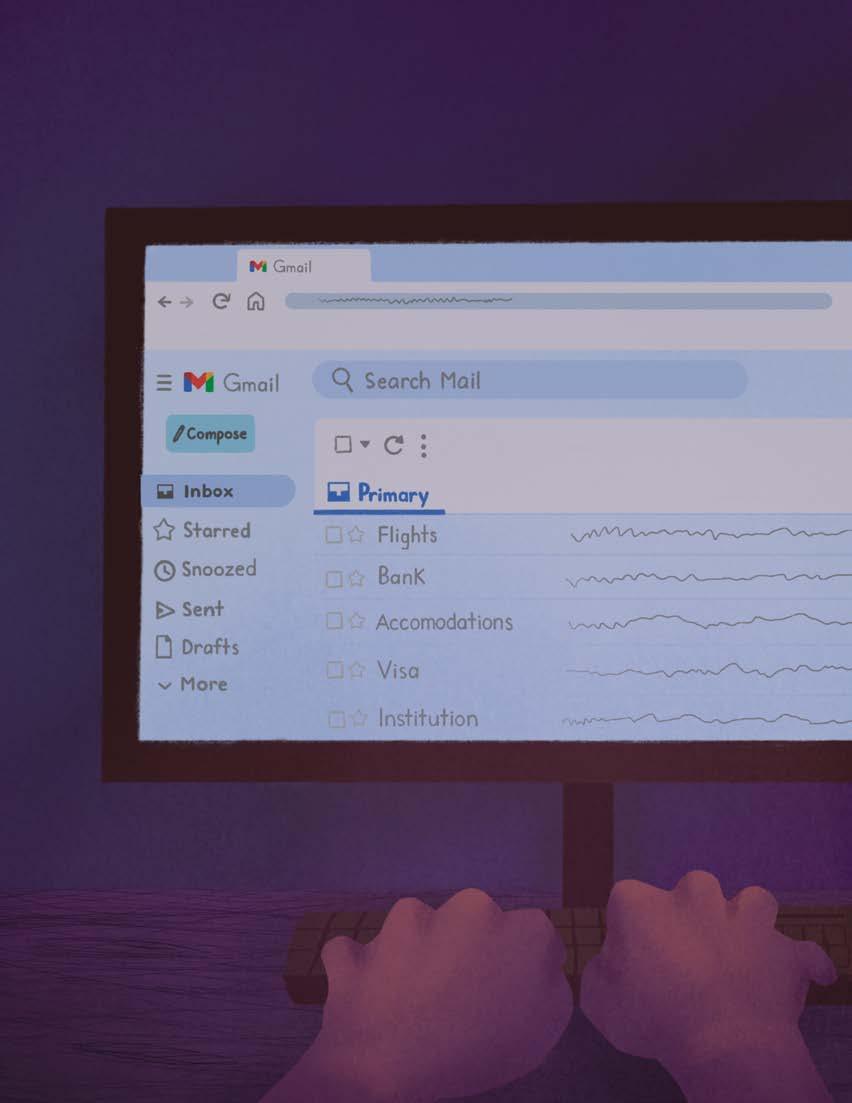
Everything about moving abroad that I learned the hard way
ARTS & CULTURE EDITOR
ILLUSTRATOR
GWEN PEMBERTON (SHE/HER) CASSANDRA VP (SHE/HER)
CULTURAL HERITAGE 60
As I’m writing this, there are less than two weeks left before my flight to Amsterdam and the beginning of my semester abroad. A mix of excitement, fear, nerves and anticipation have been building up for so long that it’s hard to believe that my trip is finally happening. One emotion I’m not feeling—or at least not as much as I expected—is anxiety.
This is not because I am a relaxed person. Anyone who knows me will tell you that I am just about as far from ‘chill’ as possible, but I planned ahead. Now all I have to do is try not to miss my flight. Before I go, I’d like to pass whatever wisdom I’ve gained on to you, because let’s be honest, planning ahead kind of sucks. If you are thinking of going abroad to continue your studies, here is my step-by-step guide.
What
do to ASAP
These are the things that you should check off your list right away, because putting them off can really throw a wrench in your plans and cause a lot of unnecessary stress down the road.
1. Apply to your host institution
After all of the forms and waivers are signed, it’s time to apply to your host university. Having your official transcript, a copy of your passport and a resume ready to submit is a good idea. Some schools may ask for other things, like a letter of intent. Take care of these and submit them early if you can, in order to ensure your place.
2. Start your Visa process
Depending on the country you are visiting, and your nationality, you may or may not need a visa for an extended stay abroad. In my case, I need a residence permit to study in the Netherlands. To check entry requirements and travel advisories for the country you are visiting, you can go to the Government of Canada’s travel site. It is also important to check your host institution’s website, as they will have more specific information about the Visa and permit application process and requirements. Don’t wait. Visas and permits can take a while to be processed
3. Check your email
I know, I know. Seriously though, there are lots of little things that need to happen before you leave the country, and they can pile up if you neglect them. It’s much less stressful to handle things as they come up than to do them all in a mad panic. Plus, you’re less likely to make mistakes, and if you do, there’s time to fix them.
4. Get accommodation
You will most likely be living in student housing while abroad. Once the school contacts you with information about housing, make sure you are ready to apply as soon as you can. It can take longer than you expect to hear about housing, so don’t be afraid to ask.
In some cities housing is competitive and you are not guaranteed a spot. Even if you have to get up early, log into that housing portal and choose your room. This might seem a little much for some, but I found that the peace of mind was worth it.
Closer to departure
Figure out your apartment situation: Whether you are ending a lease or subletting your place, you have to figure out what to do with your stuff while you are away. Start calling your parents and placing Craigslist ads now.
Insurance: Whether you are covered by the CSU Studentcare plan or elsewhere, you need travel health insurance. I would suggest doing this after booking your flights so that you know the length of your stay. If you are privately covered, you will have to purchase health insurance separately for extended trips abroad. Make sure that it covers your whole trip, and that you submit proof of coverage to Study Abroad. Print out a hard copy of your policy to keep in your wallet as well.
Get your meds: If (like me) you take any medications, make sure you have enough for the length of your stay. It can be hard to get the medications you need once abroad.
Phone plan: Decide whether you are going to deactivate your current plan while you are away. This can help save some money, but might be inconvenient once you land. You can also buy an eSIM or local SIM card once you arrive. Outside of Canada, phone plans are a lot more reasonably priced, so it shouldn’t break the bank. Personally, I’m keeping my current plan and bringing an old phone with me. That way, I can have my current SIM card and a local one for texting, calling and data. Plus, if my phone gets stolen, I’ll have a spare.
Print out your documents: In order to receive my residence permit once I land I need printed copies of my tenant’s agreement, passport photo and my permit approval. Check all of the requirements. It’s much easier to print from the CapU library than in a new country.
Register with the government: If you are a Canadian citizen, you have to inform the government that you will be abroad for an extended period. It only takes a minute though. Once you know your departure date, all you have to do is fill out the form on the Registration of Canadians Abroad website.
Make a list of emergency contacts: I almost forgot this one. It’s super helpful to have a list of emergency contacts that you can access from multiple places if you need to. On top of insurance contacts I also added the phone numbers and addresses of some people closest to me, Study Abroad contacts in Canada and the Netherlands, and a Canadian embassy locator.
Starting early and ticking things off one by one has been so helpful in my process. It gave me room to breathe, correct mistakes, ask questions and ask for help. If you’re like me, that is easier said than done, but I think you’ll be grateful you did in the long run. I certainly am.
See you in Amsterdam!
COLUMNS 61
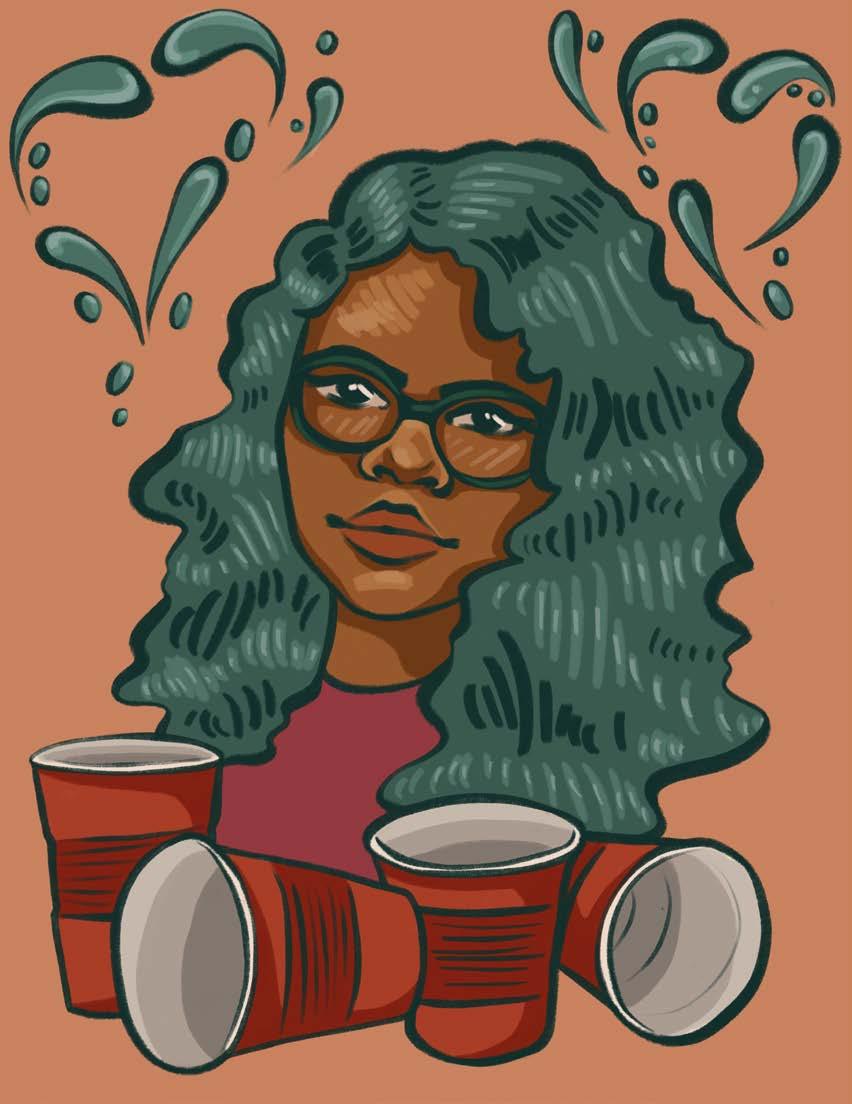
62 COLUMNS
LITERALLY SPEAKING
A different take on February novels
Dear friends and fellow studious confidants, as we move into February, I feel I’ve been more integrated into on-campus life than ever. From slowly growing out of that early semester shine and struggling through the cold rainy months, to working through my courier assignments for all of you, I’ve been thinking quite a lot about what makes a campus community thrive, and what breaks it.
This month, in my decision for this column’s book to discuss, I found myself falling through piles of classic romance novels in preparation for February (I did re-skim Emma, Pride & Prejudice, and Persuasion by Jane Austen out of my pure devotion to this column). Though, while I could compile and discuss my must-reads for lovebirds, analyze the true romance between Elizabeth Bennet and Mr. Darcy, or present my favorite contemporary love literature (I stand by what I said before, there has never been, nor will ever be a Colleen Hoover analysis in this column, that is just too embarrassing) I felt that my intentions with this month’s theme were falling shallow. Sure, while we may see February as a month for Valentine’s Day, running to school with boots lined with brown slush, and a time to fall out of our studies, February holds a much higher significance to which literature can show great value.
This month, we will be discussing the 2020 novel They said this would be fun: race, campus life, and growing up by author and journalist Eternity Martis. Martis received a bachelor’s degree from Western University in 2014. Her experiences of racism and sexism within the Canadian University campus, and through interactions with the student body
COMMUNITIES EDITOR AVERY NOWICKI (THEY/THEM) ILLUSTRATOR FREYA EMERY (SHE/HER)
led to her 2020 non-fiction novel. The novel re-told the stark differences between Toronto and Hamilton, Ontario culture and receptiveness to race and sexuality.
In a 2020 interview, Eternity told CBC, “I’ve been working on the idea for about 10 years. When I got to Western, I noticed such a difference in coming from Toronto to London, from the ways that I was being perceived and the way that people were treating me.” Eternity documented those experiences first in a blog format (as to be expected in 2011, when she began her studies at the University), before migrating the project into a play.
In a recount of her experiences encountering racism on campus, Eternity told CBC, “in my second year, I went to a Halloween party and three white students were dressed in blackface and dressed as cotton pickers and approached us. It was the stuff that you never really think is going to happen to you or that still exists. I was very shocked.” Eternity then moved to describe how community began to build between other people of color, to where she’d heard of more examples of racism on campus.
When discussing the true differences between her experiences in Toronto to Hamilton, she described that Toronto felt by no means exempt from antiblack racism, but she had only been a child when she left for London, Ontario. Eternity described it as a “hotbed for white supremacy. It’s very homogenous and very white Christian and conservative.” During her writing process, Eternity described worry of becoming a ‘sellout’, saying “I did write this for myself, in the sense that I stayed true to myself. But then I didn’t
want to write a book necessarily for white people and for allies. I wanted to write a book that I needed when I was a student. I wanted to write the book that everyone else around me needed.”
I will leave you with a quote from the novel, which can be found at North Vancouver Public Library, VPL & Burnaby Public Library.
“When I had told people back home that I was going to Western in the fall, they had similar comments: It’s the best school. It’s a party school. It’s a white school—why would you go there? Their eyes widened and they’d lean in, whispering as if they were afraid of someone hearing, and say that London was notoriously white, Christian, and conservative. They told me cautionary tales of family and friends transferring out of the school after years of microaggressions and racial harassment on and off campus.
“Don’t worry though,” they’d say with a smile. “You’ll have fun.””
63 COLUMNS

AIRPLANE MODE
Sex after service
64 COLUMNS
OPINIONS EDITOR JAYDE ATCHISON (SHE/HER)
ILLUSTRATOR CELINA ZHONG (SHE/HER)
When I got the call that I was going to be a flight attendant, my friends who worked at the airport told me that I was going to “get a lot of action” once I started flying. As a single girl, I like flirty banter as much as the next person but I never wanted to build a reputation at work, and generally tended to shy away from workplace relationships. Though I may not want to create my own work scandals, I do want to hear the gossip that others are willing to share.
Working for an airline means there is no shortage of drama to hear about—and I feel it is my duty to pass the stories on so they may show others what the world of aviation looks like after all the passengers have walked away. Sex is the inevitable outcome when you place a group of co-eds in a metal tube for hours at a time. Then to spend a night or two together in the same hotel, it seems to be inevitable.
The narrative that I was constantly fed before flying was that there would be horny pilots that would be trying to get lucky on layovers. Married or not, it would make no difference— they were going to try to get away with more than flirting.
If you’re lucky enough to have a social crew that you mesh with, crew dinners are a common occurrence. If you’re really lucky, the captain will offer to spot the bill for everyone at the table. The drinks are flowing until last call and vibes are misinterpreted (or rightly felt in some cases), and there is a knock on your hotel door not long after everyone has said their goodnights. A peek through the peephole reveals a member of the crew swaying back and forth hoping to be let in for some more fun.
Thankfully, my beauty sleep has yet to be disturbed by anything other than my own anxiety, but I have had a few jumpseat
discomforts along the way. One flight attendant that I worked alongside struggled with women and would stare a bit too long, sit a bit too close and, in what can only be described as a nasally voice, repeatedly asked me “what my type of man was” and what I looked for in a partner, sexually. “Not you” was what I almost blurted out, but I wanted to limit my bitchiness to off the clock hours.
Shutting down the nerdy coworker wasn’t hard, and once I stated I wasn’t interested in him he was polite enough to leave me alone. However, when I was on a layover in Mexico, trying to tan near the ocean, I was introduced to a pilot I would be working with the next day and he would not leave me alone. While I was limiting myself to two margaritas, this man, who was older than my parents, was downing 750ml of vodka as if it were water. Apparently it is a crime to wear a bikini on the beach because he kept insisting on giving me oral sex for he could “make me the happiest woman in the world.” He repeated that I was asking for attention in a “bathing suit like that.”
When I rejected his disgusting bravado for the final time, he threw a temper tantrum in front of the whole crew and ran into the ocean to make a scene.
While this captain ended up embarrassing himself because I was able to say no, many young, impressionable flight attendants are not always that lucky. There is a fine line between risky and risque and many people aren’t comfortable making that distinction. For now, the only scandals I am willing to take part in are accepting notes from cute passengers offering their number in a respectful manner. The rest is just hearsay I learn in the jumpseat before take-off.
65
COLUMNS

66 COLUMNS
NOW HOW ‘BOUT THAT
Meditations on Consciousness
A concussion can put one in a very vulnerable state. Early in recovery, tasks like driving, cooking, completing work on a screen and reading can be extremely tiring. Once you are capable of those tasks however, you can still deal with anxieties of going to loud places, partying and doing activities where your head is at risk of getting hit (which is more than you think). You may walk slower, not feel like going out and be very susceptible to emotional turbulence over unexpected circumstances.
All in all, the practical reality of concussion recovery isn’t necessarily the party fiesta zone other people would want to be around. But, to get through it you need help from others, you need their patience and above all you need their love.
Coming into Valentine’s Day, thinking of love, I am rushed by visions of my friends and family: My sister and mum typing assignments on my computer while I dictated, ice pack over my eyes, my nana showing up nearly everyday for two weeks to drive me to school and appointments, waiting hours in her car for me, my partner holding me in kindness while I let out every horrible, fearful thought that came across my mind, my friends extending every ounce of understanding when I cancel abruptly and every bit of care to get me out safely when I just wanted to hide away.
There are so many ways love presents itself, we expect it to be this grand presence that bangs us over the head saying “Hey! It’s me! Love! Here to solve all your problems!!!” And, in some cases, love can be exactly that—the romanticist vision of overwhelming harmony and safety. But, what I am learning in my recovery is that sometimes love is slow, unexpected and one day you wake up realizing how much love is there that you never even noticed.
2023 was a challenging year for me. There was a lot of change in my life, and with that change instability. In 2018, I had an intense realization of love and since then held that concept as the core foundation to my life. I went through a lot of growth and flourishing because of this relationship with love, it was, and still is, quite
COLUMNS EDITOR SARA BRINKAC (SHE/THEY)
ILLUSTRATOR JASMIN LINTON (SHE/HER)
a beautiful time in my life. But, slowly in 2022 as I traveled, graduated and life became more uncertain, so did my belief in a grand, baroque love. I sensed I was becoming jaded, thinking love and inspiration to be something reserved for 18 to 21-year-olds discovering life on their own. By 2023, my connection to that beautiful love had substantially diminished. I was becoming disillusioned with my dream of a career in film, got ghosted by someone I felt a deep loving connection with, had a traumatic event, suffered recurring strep due to burn out, started a new relationship I was unsure of and received two back to back concussions. I wasn’t feeling a lot of love, to say the least.
Although I didn’t find myself soaking in nature’s beauty, rejoicing in all my experiences or trusting that everything would work out in 2023, I’m starting to realize I found something else.
I liken this realization to an experience I had with a friend of mine. We worked on a project for about three months, we knew each other, not deeply, and to be honest a lot of my time during the project was spent stressing over how they would judge me for my incompetence. However, one day during my concussion they came over to see my roommate. While she was getting ready we sat on the couch and he asked me how I was doing. I began to give the standard response, but each question he had went deeper, allowing me reflection and deep catharsis. We had an honest conversation where I felt safe being vulnerable because, I realized, he knew me so intimately as a creative. As we sat and talked I looked at him and a loving mist poured over me. Softly, I realized I had a friend. I had a true, loving, caring friend, who was comfortable with me, who I could trust to be my most vulnerable self in front of and who accepted me as I was.
Like it did with this friend, I look back on all my experiences during my recovery and suddenly a soft wind floats over me. I’m not about to scream from the rooftops over it, but this loving kindness feels like a mother’s embrace I can relax in. I can finally stop
running, trying to do it all on my own. The air embraces me saying, “Here I am, love, I was always here, it’s okay now.” I want to cry with relief, I’m not alone. I had so many people there for me, caring for me, waiting for me with empathy, understanding I was in pain and helping me through it. The love contained in these memories washes over me whispering “you may not see me all the time, you may not have recognized me back there, but it was me, I’ve been watching, you were safe then, you’re safe now, you always will return to safety. I love you.”
I have moved very fast for a very long time. I haven’t always seen love in all of its forms and I haven’t always slowed down long enough to brave life’s uncertainties. But being forced into a slow recovery I have reconciled with many fearful things. Things I could not do quickly and have big gigantic loving answers for, instead they were things that took time that consumed me and scarred me but gave me great wisdom in return. I am grateful for my chaotic year and its myriad of experiences. It showed me the many ways of life, like a flower in spring I have braved the winter and although I may be just a tiny bud at the moment, I am beginning to see the great potential of what could bloom. In my bud I am embraced by the belief that life, although a journey of chaos, remains held together by the sinews of Love. Huh. Now how ‘bout that.
67 COLUMNS

CONTRIBUTOR & ILLUSTRATOR
LUCY BENSON (SHE/HER)
Squash your loneliness with our brand new Courier Companion (Romance Edition). Cut her out and behold! The paper partner of your dreams.
The Face itself. So stunning, it makes sunsets reconsider their career choices. Greener than your friend’s jealousy and smoother than your last hair flip.
Surprised eyes, thats say “no way babe! They really said that babe?” These eyes have witnessed more plot twists than a telenovela. Popcorn, anyone?
An array of lips. What cheeky secrets are these lips keeping? Smooch responsibly people!
Pink glasses. Rose-colored, because everything looks better when you’re seeing it through these bad boys. Even your failed attempts at cooking. #ChefInTheMaking
Eyebrows, the height of facial language. These brows speak volumes, louder than your 3 a.m. snack cravings. No judgment, just well-arched brows.
Sultry eyes, oh yeah babe, those sweatpants you’ve been rotting in this semester look oh so fine. These eyes are here to validate your questionable fashion choices. Embrace the cozy!
These eyes are all dolled up for a night out. Where will you take her? Perhaps the Birch food court? What a gentleman. Get ready for a feast fit for royalty – served on a plastic tray. #DinnerAndDisappointment
1. 2. 3. 4. 5. 6. 7.
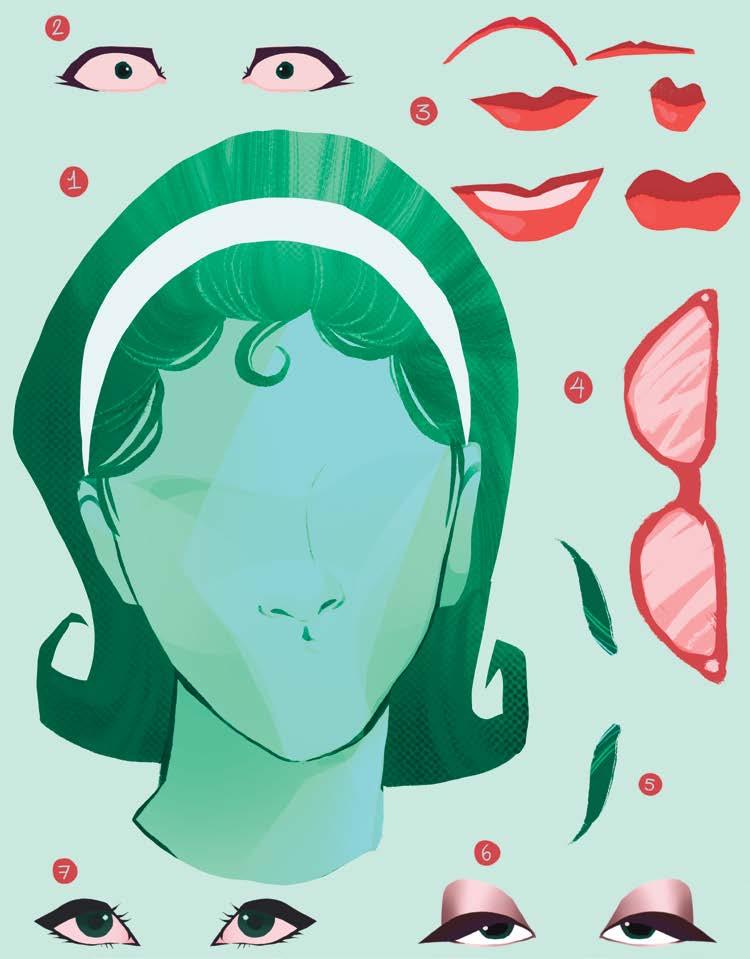
69

Unlock
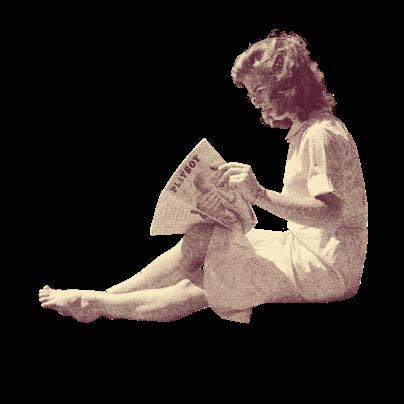
ADVERTISE WITH US!
the potential of this premium advertising space! Your message deserves a spotlight, and this is where it shines. Connect with your desired audience and amplify your brand’s visibility with us.
COURIER CORNER PODCAST SPOTIFY YOUTUBE APPLE PODCASTS 71
To secure your ad space or for any inquiries, please feel free to contact us at editor@capilancourier.com. We look forward to helping you make a significant impact through our publication.
CAPILANO UNIVERSITY is located on the traditional unceded territories of the LíỈwat, xʷməθkʷəỷəm (Musqueam), shíshálh (Sechelt), Sḵwx̱wú7mesh (Squamish) and SəỈílwətaʔ/ Selilwitulh (Tsleil-Waututh) Nations.
We recognize our presence here as guests on this sacred land and deeply appreciate the privilege to work, study, and reside in this remarkable place. The Capilano Courier acknowledges that this gesture is just a starting point on the path to reconciliation, and we are committed to amplifying Indigenous voices and sharing their stories.
THE CAPILANO COURIER is an autonomous, democratically-run student newspaper that encourages literary and visual submissions. However, all submissions undergo editing for brevity, taste, and legality. We are committed to not publishing material that the collective deems as promoting sexism, racism, or homophobia. The views expressed by the contributing writers are not necessarily those of the Capilano Courier publishing society.
Additionally, we prioritize a human-centered approach to content creation and do not support the use of AI in our editorial processes. We believe in the value of human perspectives and storytelling in our publication.
Maple Building 122
@CAPILANO.COURIER
CAPILANO COURIER
VOLUME 56, ISSUE NO.6

 Freya Emery (she/her)
Freya Emery (she/her)
 FREYA EMERY (SHE/HER)
Editor-In-Chief
FREYA EMERY (SHE/HER)
Editor-In-Chief









































































